A shoulder to cry on
Everyone can use a good cry. When we no longer hold our emotions in check, the floodgates open up and we feel some sense of relief. This is seen in real time with Joseph, our main character for the ending of Genesis. To understand his emotional state in Vayigash, we have to first take a look at Mikeitz. In this portion, Joseph sees his brothers but soon realizes that none of them recognize him. With that context, we see below:
(24) He turned away from them and wept. But he came back to them and spoke to them; and he took Simeon from among them and had him bound before their eyes.
Joseph was able to hide his tears simply by turning away- imagine shedding a single tear or getting a little “sniffly.” He’s able to contain his emotions in the same room. That all changes when the brothers continue to use a translator to communicate. It becomes harder and harder:
(30) With that, Joseph hurried out, for he was overcome with feeling toward his brother and was on the verge of tears; he went into a room and wept there. (31) Then he washed his face, reappeared, and—now in control of himself—gave the order, “Serve the meal.”
The tears flowed to the point that Joseph’s face became flushed. He needed to wash up just to see his brothers as the minister (still not as their brother). That’s the story of our previous parasha, Mikeitz. We are left with a cliffhanger, as Joseph has identified his brothers, but his brothers have yet to figure out that the super important minister of Egypt is in fact their long lost brother, a man they had left to die.
(1) Joseph could no longer control himself before all his attendants, and he cried out, “Have everyone withdraw from me!” So there was no one else about when Joseph made himself known to his brothers. (2) His sobs were so loud that the Egyptians could hear, and so the news reached Pharaoh’s palace. (3) Joseph said to his brothers, “I am Joseph. Is my father still well?” But his brothers could not answer him, so dumbfounded were they on account of him.
Finally able to shed a tear, Joseph cried out- our commentators discuss whether or not Joseph felt embarrassed, or on the flip side, if he sent everyone out of the room to not embarrass his brothers…either way, this is a chance to be finally let it all out.
(12) You can see for yourselves, and my brother Benjamin for himself, that it is indeed I who am speaking to you. (13) And you must tell my father everything about my high station in Egypt and all that you have seen; and bring my father here with all speed.” (14) With that he embraced his brother Benjamin around the neck and wept, and Benjamin wept on his neck. (15) He kissed all his brothers and wept upon them; only then were his brothers able to talk to him.
A second layer of crying- no longer just the wailing, but the embrace and the kisses- seeing his brother Benjamin (and Benjamin understanding that he’s seeing his long lost brother Joseph) is a full body experience.
And finally, Joseph meets up with his father, someone who had prayed for his return for some 22 years.
(29) Joseph ordered his chariot and went to Goshen to meet his father Israel; he presented himself to him and, embracing him around the neck, he wept on his neck a good while.
The singular use – that “he wept” and not “they wept” is puzzling. Rabbi Samson Raphael Hirsch writes,
Yosef cried; Yaacov no longer cried. Yaacov already finished crying, but Yosef just began when he spoke with his father… Yaacov had lived until this point a life of constancy: He cried for Yosef. His grief ruled his entire emotional/spiritual being. Yosef’s life, on the other hand, abounded with change and flux, and he never had the time to turn his heart to the pain of his separation [from his father]. He was always preoccupied with the present. Only now, at the moment when he fell on his father’s neck did he feel all the agony of that separation, and he re-lived all of those 22 years past.
For all the crying of these two torah portions, Jacob does not cry. One can find power in the rabbinic view that Jacob had been crying for all those years and just had nothing left. But I’d like to consider another option. Joseph wept on his father, embraced his father, and Jacob took it all in. By feeling the embrace of his son, hearing his cries, it made the experience no longer a pipe dream but a real one. The physical touch of someone he had longed for was so powerful that beyond the wailing, he could just BE in the moment. For me, that is the essence of this parsha. Yes, we leave windows to cry, but the greatest embraces that take place are when Joseph can finally be Joseph with his brothers (no more hiding), when he can finally embrace the man who has cried for him for 22 years. To be present, in the moment, without inhibition, is the essence of our parsha. As we look to the tensions that exist in our interactions- with estranged loved ones and friends, with political opponents, it’s a reminder that you don’t always have the right words to say; the tears don’t automatically flow at the moment you think you can plan for them to flow. To fight through the tensions, to pierce the heart, to feel the embrace of connection, all we need to be, is present. If we don’t show up, open our hearts to possibilities of repair, words and emotions will never succeed nor will they fail, for they will never happen. To be present, or not to be present, that is the question.
To be a dream: Shabbat reflections from CA solidarity mission
I want to talk about dreams. The opening line of Psalm 126, our Birkat Psalm, reads “When the LORD restores the fortunes of Zion —we see it as in a dream-a—” Any trip to Israel should be just like that, a dream.
But Israel is in a time of trouble, seemingly far from the dreams of our ancestors. The Hebrew word for nightmare is סיוט, based on a word used in a talmud story about demons that appeared to King Saul in a dream. It shares the same Hebrew root as להסיט, meaning “to divert.” A nightmare hopes to divert our attention, our focus from the hope and potential that help make dreams possible. But if there’s a word to describe this time of year, the Israeli people, it is resilient, even in times of despair.
More telling than anything else is that in times of trouble, we go to the Psalms. Psalm 126, the dreaming Psalm, contains these words, “Those who sow in tears, will reap in joy.” Sowing in tears is not a linear motion- as if once we have planted seeds of sadness we will automatically head to future songs of joy, without any reseeding necessary. When I visited Israel last week, joy and sadness occupied one hand. Frustration and hope, the other.
As we flew over the Atlantic, from Tel Aviv to New York, the mood was changing in Israel. Hamas broke the ceasefire by firing into Israel, by not sending a new list of hostages to be released. Yes, the 7 day ceasefire that saw over 100 hostages released, that had enveloped our entire 5 day journey, was over. It makes this experience unique, a rega b’zman, a moment in time. A country at ceasefire is now filled with sirens in Tel Aviv and Ashkelon, military battling on the ground in Gaza.
The psalmist writes in psalm 121,” Hinei Lo Yanum v’lo Yishan, SHomer Yisrael”, “the guardian of Israel neither slumbers nor sleeps.” Israelis, the literal guardians of Israel, neither slumber nor sleep. The resilience of this country is unbelievable.. While the resiliency was born as an indictment of Israel’s government, the intestinal fortitude of each Israeli to push on, to have open hands and hearts to family and strangers, is something we on this side of the Atlantic can learn a lot from. Israel mobilized, and we CAN do the same- for our own communities and for the state of Israel.
We visited hospitals, military bases, and interacted with those mobilizing volunteer efforts. No one has a moment to breathe…on one end you might imagine that with human resources at an all time low solidarity missions would be a burden- but at no point did it feel like a burden to be there. In fact, the opposite- every Israeli we met with thanked us wholeheartedly for our presence, our “bravery.” They sent US strength with what is going on in the states. No greater example would be when we visited Ashkelon, a city bombarded by 2000 rockets. The community members described their anxieties, but followed with a pitch to move to Ashkelon, the “greatest city. “
Yizhar Hess, who previously served as the Executive Director of the Masorti Movement in Israel and coordinated our last Cantors Assembly leadership mission in the summer of 2022, framed our main responsibility as shlichim, emmisaries, in a discussion we had midway through our mission. Our responsibility was, and is, עדות, witnessing. He shared the following story:
Considered by many the most influential secular Jewish poem of the twentieth century, Bialik’s “B’ir Haharegah (In the City of Slaughter).” was published in 1904 in the aftermath of the Kishinev pogrom of 1903. It influenced the development of a Zionist ethos — looking for an alternative to a place like Kishinev where, Bialik wrote, “the heirs of Hasmoneans lay, with trembling knees, concealed and cowering — the sons of the Maccabees!”
The large Jewish community of Kishinev, a small city in the Russian Empire in what is now Moldova, was attacked over three days, beginning as church services ended on Easter Sunday. Forty-nine Jews were massacred and bodies littered the streets. Many more suffered unspeakable atrocities and homes were torched.
The zionist movement changed, the view of European jewry changed, because Bialik was there to bear witness, and share that story with others. And so this morning, I want to share about 3 stories:
Story #1
Our first stop was the Hadassah rehab unit on Mt Scopus. Most of the patients we met were battling injuries inflicted by Hamas terrorists on October 7. We sang songs of healing, Israeli standards to cheer up the staff and residents. As our group was finishing a set of songs, a gentleman came up to us asking for us to meet his brother, Eden. Eden was shot point blank in the chest just 10 days earlier, as three armed terrorists opened fire at a checkpoint. Eden saw something suspicious. Eden shared many details of that morning-
3:40AM: called avram to be on guard, put on tefillin, put on bulletproof vest and had briefing on checkpoints – between gush and Jerusalem
Finished briefing 4:30AM – went to position
5:30AM- made to checkpoint
Headed to Lane 1- at 7am, Avram relieved him
7:45AM- open another lane (relieved Avram)
Lane 2 was filled with daati, religious individuals
Saw from far – a car caught his eye – license was upside down, had Magein David on dashboard…
He told the car to stop; asked lots of questions – theydidn’t answer. ID papers? didn’t answer; how old? Siblings? 3 people in car said “kol bseder” I’ll come give you a picture…
At point blank one of them takes a gun, opens the door and yells allah akbar, shoots Eden in his chest.
His friend Avram was killed, succumbing to his wounds. Later Eden adds that the sheer force of the bullet ripped the tzitzis underneath.
This soldier’s brother knew how therapeutic it would be to tell his story, just as others tell their stories. Even though Eden kept saying “Sababa,” you could feel how he had yet to process all that had happened. Sababa, an expression of enthusiasm, “cool,” is Eden finding a way to cope with the trauma of that morning and the loss of his friend.
As we find out that this is the first day Eden has walked on his own, Eden says “Avram is with me.”
Story #2
As we enter into Kfar Aza, our guide gives us a little context for this community: 950 members, more than 60 murdered; 10 kidnapped to Gaza, burned houses. The displaced refugees are in the south of Netanya – in hotel rooms or apartments/houses subsidized by the government and friends of the community.
In many ways, visiting a place like Kfar Aza should come across as visiting a concentration camp- the smells, the sights of destruction, paired with the stories of atrocities and war crimes, are so overwhelming that I don’t know when I’ll fully process what I saw. And yet visiting Kfar Aza, led around the Kibbutz by a survivor, Gon, who fought off 40 Hamas terrorists, is so far removed from any trip I ever made to Majdanek, Auschwitz, or Dachau. For in truth, this is the balance of life here- Kfar Aza is the sight of a massacre, a shiva home to those who mourn, and ALSO a Wonderful place “ you should be jealous” our guide tells us that you would be living in a place like Kibbutz Kfar Aza, a privatized kibbutz home to over 900 members with a long waiting list to get in. This is a place that for now is frozen in time (sukkot are still up) and yet it is where the living want to return and will return, a place of loss AND a place, God willing, of life. No one knows what this place will look like tomorrow- a museum, a memorial, a moving tribute AND a place to move forward, to live on.
Seeing so much destruction is sensory overload: images of rubble, toys, trash, bullet holes. An image sticks in my brain- it’s of a single card from the game “Spot it.”All three of my children play this game at home with us. Seeing the card, finding it in our own playing deck, reminds me that Hamas attacked the young, the innocent. It’s a rallying cry for me to continue to share the beauty of the members who were lost and who suffer the trauma of October 7, the hate and premeditated barbarism of Hamas, and the hope of what Kfar Aza may be for generations to come.
We ask Gon how he can walk around this space, so soon after experiencing this trauma. He says, “Many are not with us anymore. Someone needs to tell the story. And one day, we want to come back here (to live).”
Story #3
We visit the Hostage and Missing Families Forum, known through the hashtag #BringThemHomeNow. According to their website, the Hostage and Missing Families Forum was formed by the families of the abductees less than 24 hours after the horrific attack by Hamas on Israel on October 7th. The Forum is volunteer-based and laser-focused on bringing the hostages back home to their families, to us.
Our guide Meirav reiterates the volunteer nature of this NGO as people work around the clock in addition to, in many cases, full time jobs. The two goals are to keep the return of the hostages in the forefront of the political agenda as well as supporting the families of the hostages. We meet members of a number of the teams- the diplomatic team mobilizes awareness in their own governments, the medical team provides mental health resources for families and supplies medical info of the hostages to the Red Cross, whom Meirav describes as acting like a GETT taxi driver, refusing to offer medical attention when needed; the legal department, communication department (think of all the billboards in 90 locations around the world); the social media team who write everything in Hebrew AND in English; and the influencer department.
After the terrors of October 7, Dudi Zalmanovich, a prominent Israeli businessman whose daughter survived the massacre at the Nova music festival and whose nephew was taken captive by Hamas, emptied two floors of his office and gave birth to the forum. We hear Dudi speak about the days immediately after and how the forum is adapting to the reality of some hostages being released. A number of times, he says that it doesn’t matter Israeli or non-Israeli, Jewish or not Jewish, they want all of the hostages home safely and home speedily. After we sing a very emotional Acheinu (a literal prayer for hostages) in our little hallway, Dudi’s statements come into play in real time, as a family member receives a phone call right next to us that Aisha Ziyadne, from the Bedouin community of Ziyadne, is one of the captives being released (if you’re thinking Bedouin – a reminder that Hamas doesn’t want people of all religions living on this land). Later that night, we learn that her brother Bilal is also released. After an embrace, As Dudi puts it, “to see this person so drained yesterday and now today” Even in the joy of the moment there are still other family members in captivity.
Everywhere we looked, from Hadassah hospital to the streets of Tel Aviv to the roads to the southern kibbutzim, we saw the slogan “b’yachad ninatzeach” often translated as “together we will win.” In reality, the slogan reads more like the verb, lehitgabeir, to overcome. Together we shall overcome. Our humanity and caring for eachother will get us through these difficult times. It is the crying call of every Israeli we meet.
For our goal is two pronged- just as we speak of the inhumanity of Hamas, we MUST speak of Israeli expressions of humanity. Facts and figures are important, but human touch points will be what is needed to change the narrative. When our group shared those last moments of gratitude, our videographer Or (you’ll see his work soon thanks to funds we raised at the JJC), said that WE are the hope. WE, the cantors on this mission, and WE Israel’s family and friends in the diaspora. This isn’t something Israelis would’ve said two months ago…Together, Israel and diaspora, are the hope. Just as we can have boundless love, we can always have boundless hope- hope for the return of hostages, for peace, for a people of Israel that thrives for generations to come.
I want to get back to dreaming, dreaming of a beautiful and strong Israel, making dreams become a reality. And that is where we all come in.
By adding light- light to publicize the miracle of Hanukkah, AND to publicize the massacre of October 7.Be the light by engaging in dialogue and by going to Israel (remember, it’s not a burden). Israel needs you. You ARE and will be, the hope. Be the light- the light for the lives taken, the light for those in captivity who need the light to bringthemhomenow -from darkness to light….mei-afeilah l’orah…speedily in our day.
Cantors Assembly Solidarity Mission Day(s) 1
Day(s) 1:
Grateful to be participating in our Cantors Assembly Solidarity Mission representing our officer core and the Jacksonville Jewish Center.

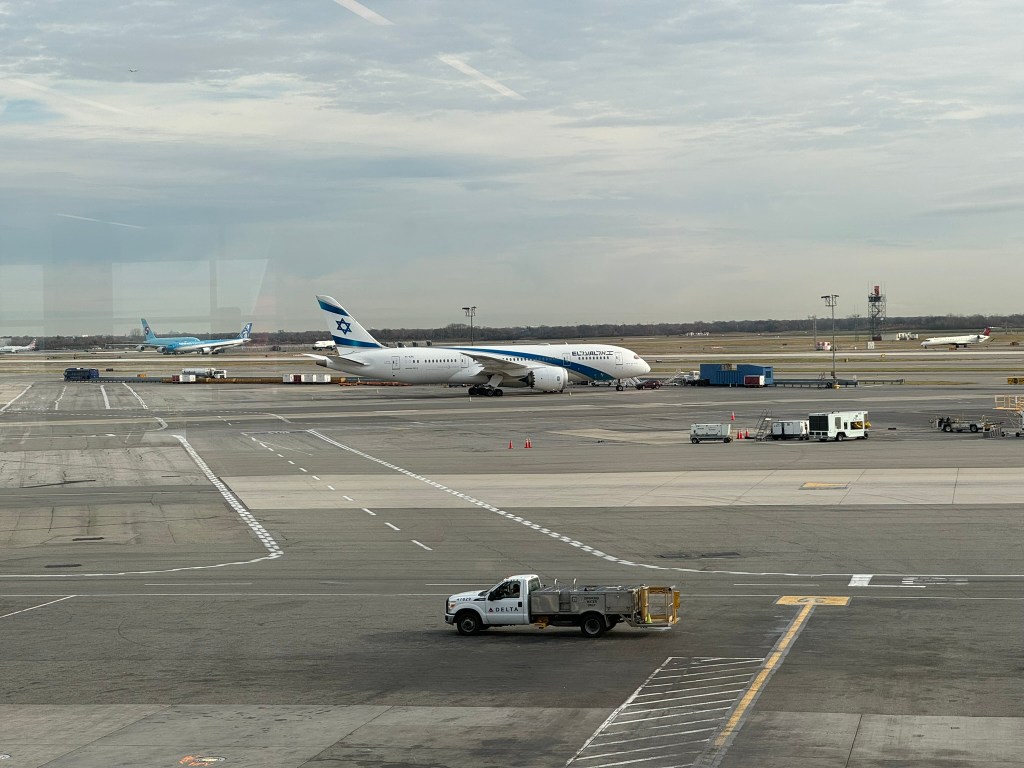

Following a long travel day(s) that began before 5AM Sunday, I boarded an El Al flight to Israel (my first ever flight on El Al). I will say that there is something powerful about having an entire plane of people eating kosher plane food.

The loudness of our flight was met with a deafening silence of Ben Gurion Airport- empty gates, empty customs, but one thing remains- the reminders of war-time Israel: the photos of those still kept hostage in Gaza (a number of those now famous photos have been removed now that 50+ hostages have been returned), signs for shelters…


As we met our guide Carmit, rain began to fall during our drive and for the remainder of the day. As a people who normally pray for rain, she reminded us of the new reality of rain- soldiers, hostages in conditions where rain is not a friend. Just another layer that speaks to this duality of the life Israelis and many Jews are experiencing (this will become more evident as we meet with families of hostages- rejoicing in return while dreading what is to happen to those who remain).

Our first day consists of really two parts – a visit to Hadassah rehab unit on Mt Scopus (always love to our Jacksonville Hadassah ladies!!) and a dinner conversation with Gil Hoffman, former chief political correspondent for the Jerusalem Post and executive director and executive editor of the pro-Israel media watchdog HonestReporting.
For security reasons I can’t share photos of a number of soldiers and police officers that we met with who are rehabbing major injuries. Most of the injuries happened from battling Hamas terrorists on October 7. We sang songs of healing, Israeli standards to cheer up the staff and residents. I will share more of these stories in the coming weeks, but I did want to share a portion of one story. As our group was finishing a set of songs, a gentleman came up to us asking for us to meet his brother. His brother Eden was shot point blank in the chest just 10 days earlier, as three armed terrorists opened fire when Eden saw something suspicious. Today was the first day he had walked on his own since the incident. Eden shared many details of that morning- of losing his friend who succumbed to his wounds. He shared how he put on tefillin that morning, right before he put on his protective gear that saved his life (and I might add, the sheer force of the bullet ripped the tzitzis underneath). This soldier’s brother knew how therapeutic it would be to tell his story, just as others tell their stories. Even though Eden kept saying “Sababa,” you could feel how he had yet to process all that had happened. More on that story another time…



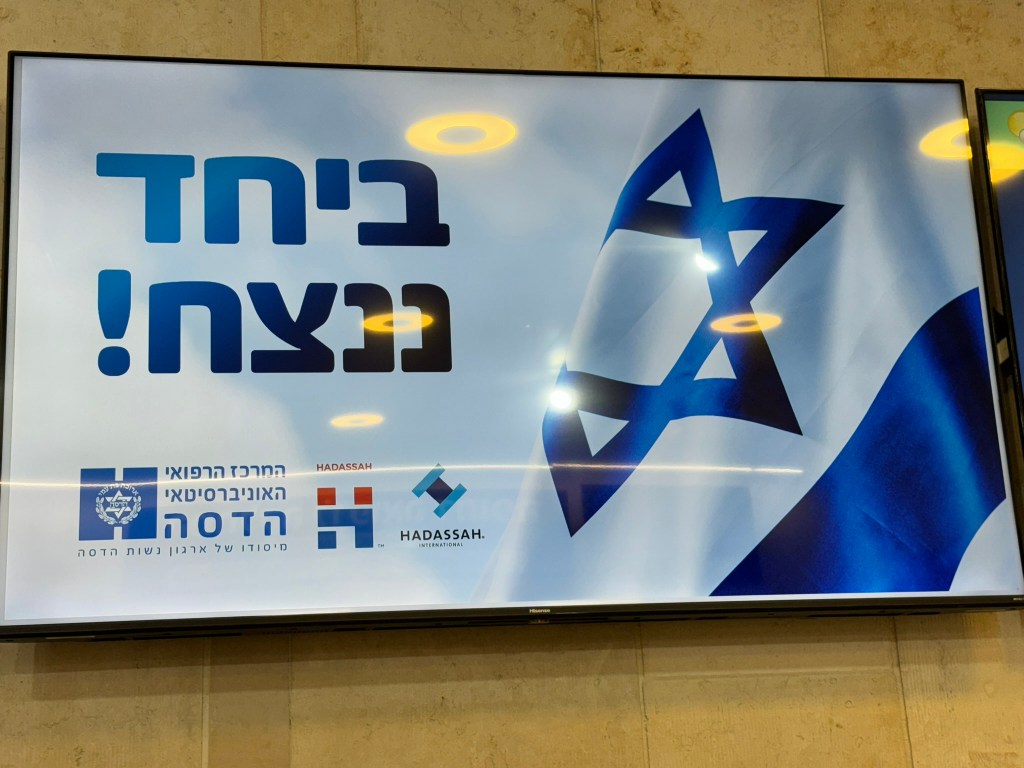
Gil Hoffman, just as he has done twice already at our synagogue, gave a straightforward analysis on the situation we are in, the situation we came from, and possible situations we may be headed towards. His new position at HonestReporting is vital to calling out issues of journalistic integrity- getting your news from Hamas isn’t a reputable source, people. As we were leaving, a group member asked what we could bring back with us. Gil responded, “Mandatory Israel Education, pre-bnei Mitzvah.” An ability to chant a haftarah is great, but if we don’t instill a sense of peoplehood or an understanding of the State of Israel (beyond a religious symbol) then we are in deep trouble. This battle will be fought in the military, on college campuses, and in social media, and it really all begins and ends with honest reporting.

That’s it for Day(s) 1. Tomorrow will be a very heavy day as we head south to do more witnessing and volunteering.
Finally, a plug: if you are in Jerusalem on Wednesday night, join us as I join my cantorial colleagues and Hila ben David for a beautiful concert at the Old Train Station!


Cantors Assembly Solidarity Mission Day 2 Part 1
Day 2
When I sent a note to our congregation, I said that this mission meant “volunteering, sharing music and being a pastoral presence to those affected by the ongoing conflict.” Our day consisted of all of those elements through one important lens of Eidut, witnessing. We spent the majority of our Tuesday in the South (also known as Western Negev) in communities directly impacted by the events of October 7th. My reflections will hopefully be divided in two parts for a number of reasons. The first is the amount that I am still trying to process, and the second is that the pictures of the day reflect two conflicting emotions. So for today, the pictures you’ll see on facebook reflect our moments of learning and of moral boosting ruach. The other pictures serve as an important witness to the atrocities of Kibbutz Kfar Aza. Those reflections come a bit later with a link to my blog (with photos to be found there). There is never a real “trigger warning” on Facebook, so fingers that do not scroll fast enough may see sites that are too confusing or difficult to hold at this time.

To Tuesday: A beautiful walk around Jerusalem with my friends and colleagues Tahl and Asa followed by a breakfast of all breakfasts (photo below).

We were debriefed on the Gaza situation by Col. Res. Grisha Yaakubovitch, who served in the IDF Civil Adminstration in the Gaza region. Grisha is an immigrant from the former USSR, son of Holocaust survivors.

Grisha paints a dark reality, but like others we will speak to, he speaks of unity through tragedy. The information he provided is important to grasping the “nuance” we often feel isn’t portrayed in Western media. As retired military who worked and befriended Arabs in the West Bank and Gaza, Grisha explains the “Holy Fuel War” as Hamas paints a story far from reality- while Israel provides 12% of water resources and at one point as much as 40% of Gaza’s electricity (the number today isn’t as clear), Hamas as governing body has let its people suffer. Just think of the 500km of tunnels underground to help fighters when they could’ve build shelters. In Hamas’ eye, it’s the UN’s responsibility to help Gazans.
In Grisha’s words, our main takehome was to “believe the unbelievable.” Hamas and Isis ideology go hand in hand – all they get and want is incitement. The plan of October 7 was intentional, horrific, yet simple. As Israelis ran to take cover from rockets, Hamas used that 10 minute window to begin its assault on innocent victims in Israel. Hamas and its leader Sinwar are the heroes of the street. In a raw moment, Grisha shares that he felt betrayed by those enemies who became friends who now became enemies of oct 7, yet “ Revenge” doesn’t make him feel better – it’s just waste of life. He has anger and rage towards those who support Hamas’ aggression and terrorism, BUT he prays and knows that that rage will subside in the days ahead, God willing.
Did I mention this was the lighter part of our day?
After our meeting we hopped on our armored bus with a quick stop to pick up our guest for our trip South. HIla Ben David is a sensational singer who will be leading our concert tomorrow night. She would otherwise have been unable to visit the places we visited today because she does not have any active military in her family. I know her being with us for these difficult hours was important to her and to our group and will only make our concert together that much more meaningful.
Our morning concluded with a visit to Alumim base, where 450 reservists are gathered to watch over kibbutzim that neighbor Gaza. 150 are here on base watching Kibbbutz Alumim.
We are greeted by Ben Hardin, friend of one of our colleagues Ben Tisser.





Ben grew up at Valley Beth Shalom synagogue in LA, was active in USY and went on Nativ year course before making Aliyah. When he isn’t in the reserves, Ben works as Coordinator of Development and Lone Soldiers for a company called Israel-is, an NGO that helps Israelis to represent and share Israel while traveling abroad and engaging online. Ben describes the moment when everyone got the alert on October 7. Even before he got his orders, Ben was en route, only to find that over 600 soldiers had already shown up for duty. It was another “one for all and all for one” moment that reminded me of my rush to donate blood the late morning of 9/11, only to find a line wrapped around city block after city block. As Ben puts it- “all of us, a week earlier we would’ve been arguing.” But they went to Kfar Aza, where ZAKA was there with 15 ambulances filled with bodies. For 90 minutes that same battalion that would’ve been arguing stood there reciting Kaddish, crying. After a week of protecting the kibbutz and area to the border, his unit moved to Kibbutz Beeri for one month (a Hamas terrorist was found weeks into the conflict on the kibbutz itself), returning to Alumim two weeks ago. Ben gives an important view point as an American-Israeli- first, the level of impact on families- they don’t really show us what they’re feeling. The second, the balancing of sharing facts (and it’s so important to know and share the facts), but that at the end of the day people connect to people before they connect to ideas. Engaging narratives speak louder than meticulous notes.
I was struck that his aliyahversary was Chanukkah 2017, as Ben spoke of a number of miracles that saved lives on October 7.
- Hamas didn’t know that the alumim base existed (knew kibbutz), so when the attacks took place, the base ran into action; casualties were kept at a minimum to those who were unfortunately in the fields (foreign workers)
- On Oct 6, the 890 battalion paratroopers were preparing for a drill in full combat gear. They were ready that day, near the Dead Sea. The battalion was transported by helicopters; the last one was hit with an RPG- yet able to land, its troops able to run 100 m before it exploded
- Ben’s CEO happens to also be a Captain in matkal and with rifle in hand was able to help those same soldiers to safety before the helicopter exploded.

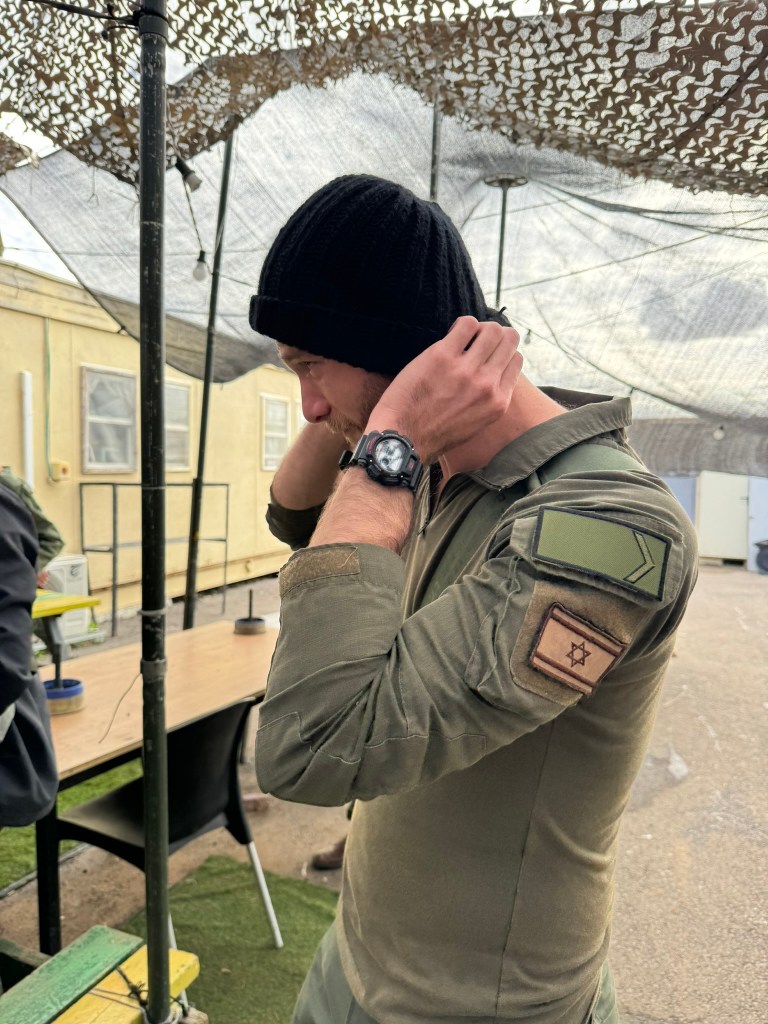


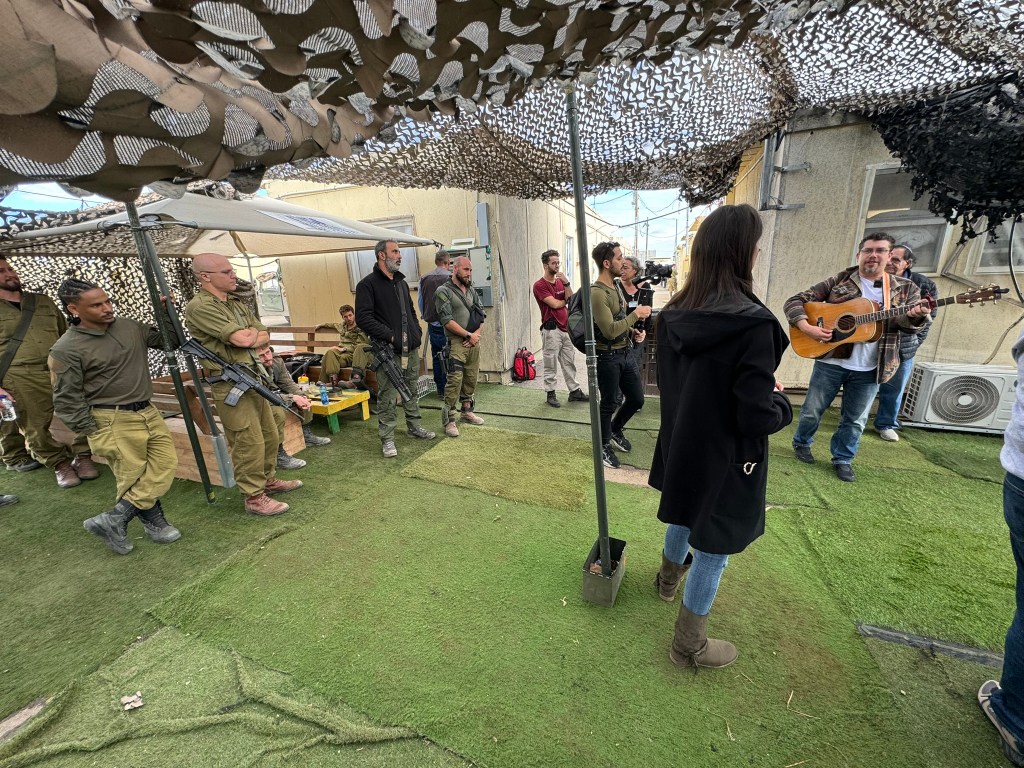
We felt a great sense of “Am Yisrael Chai” when we gathered with the unit for singing. We sang everything from Oseh Shalom to a prayer for the IDF to Kol Haolam Kulo. Of course my highlight was sharing hats knit by members of our synagogue, an important gift to the soldiers as many Mluim (reservists) don’t have access to the same gear that those in active military have. Smiles and hugs as we approach the hardest part of our trip. Part 2 to come soon.
Cantors Assembly Solidarity Mission Day 2 Part 2
Day 2 Part 2
I’ve mentioned throughout my life that the most spiritual and impactful journeys of my life were not found in Israel or in the United States, but in the ravaged communities of Eastern Europe- to understand a vibrant history, the untold stories of 6 million of our people, made visiting the concentration camps more than just a place of massacre and loss; they became a place to share in not only how people died, but how they lived and how they should’ve lived for generations to come.
In many ways, visiting a place like Kfar Aza should come across as visiting a concentration camp- the smells, the sights of destruction, paired with the stories of atrocities and war crimes, are so overwhelming that I don’t know when I’ll fully process what I saw. And yet visiting Kfar Aza, led around the Kibbutz by a survivor who fought off 40 Hamas terrorists, is so far removed from any trip I ever made to Majdanek, Auschwitz, Dachau or any of the camps I’ve visited. For in truth, this is the balance of life here- Kfar Aza is the sight of a massacre, a shiva home to those who mourn, and ALSO a Wonderful place “ you should be jealous” our guide tells us that you would be living in a place like Kibbutz Kfar Aza, a privatized kibbutz home to over 900 members with a long waiting list to get in. This is a place that for now is frozen in time (sukkot are still up) and yet it is where the living want to return and will return, a place of loss AND a place, God willing, of life.
Before I continue with a few more details and photos on my blog, two photos of note- the first reminded me of a photo I took on a Cantors Assembly mission to Germany- a photo of a small flower growing out of the rubble of Dachau Concentration camp. As a number of missions and soldier groups have made their way through the crime scene, there are small gestures here and there to remind people that the people of Israel are here to be witnesses.
The second photo is a single card from the game “Spot it.” Seeing so much destruction is sensory overload, but finding this playing card within the rubble hit hard. All three of my children play this game at home with us. The goal is to match a single item from the dealt card with the card at the top of your pile. So metaphorically, I felt the importance to be that other card- to find one person, one anecdote that people might remember, so that they see the beauty of the members who were lost and who suffer the trauma of October 7, the hate and premeditated barbarism of Hamas, and the hope of what Kfar Aza may be for generations to come.


As we enter into Kfar Aza, our guide gives us a little context for this community:

950 members, more than 60 murdered; 10 kidnapped to Gaza, burned houses. The displacement shvaim (refugees) are in the south of Netanya – in hotel rooms or apartments/houses subsidized by the government and friends of the community.
We are met at the entrance by Gon who lives in Kfar Aza- a husband and father to a new baby. His brother, sister and parents all moved to Kfar Aza as well, because this is/was paradise. Some of the photos I’ll be sharing speak to this beauty (that even remains in parts of the kibbutz). they never thought something like this could happen, that 300 terrorists would massacre this community.
He explains that there were 3 waves of attack, led by Bakai (motorized gliders) that made their way over the Gaza border that morning and landed in five different places around the kibbutz. It’s clear that Hamas had a map (Google maps also has a clear outline of the kibbutz). The attackers knocked out the Kibbutz armory called the niishkiya- place where they held all the kibbutz’s weapons. This was just past 6:20 on the morning of October 7. By 7am, there were 100 terrorists in the kibbutz. Most of the destruction outlined in my photos is from the neighborhood known as Dor Hatzeir- a place where most of the young singles live- there are very few survivors of this neighborhood.
The battle went from Saturday to WEDNESDAY before the last wave of Hamas terrorists fled or were killed. We hear stories of heroism as WhatsApp and other forms of technology are used to warn kibbutzniks of what’s transpiring; we hear horror stories of safe rooms being anything from safe from the actions of Hamas (The “Mamad” safe room is not bullet proof, even if it is safe from the impact). The images of burned houses and safe rooms, bullet holes in one area are met with other images of neighborhoods that appear more intact – sukkot still up, little physical damage; although this does not reflect the mental toll on anyone who lived through this trauma.

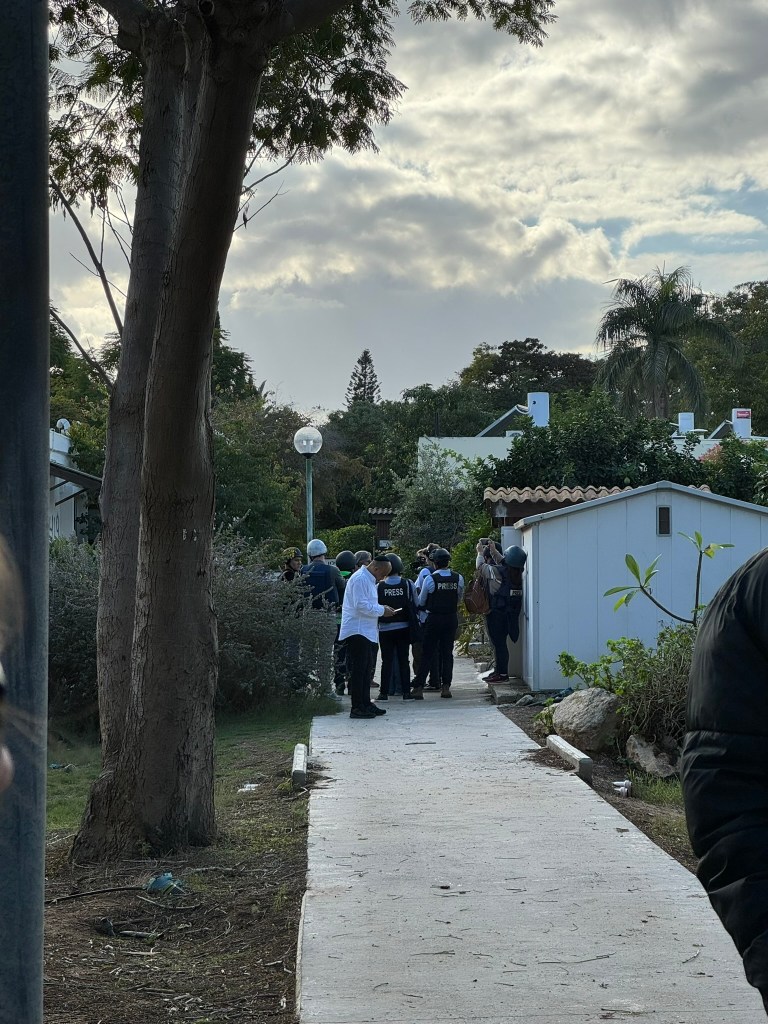

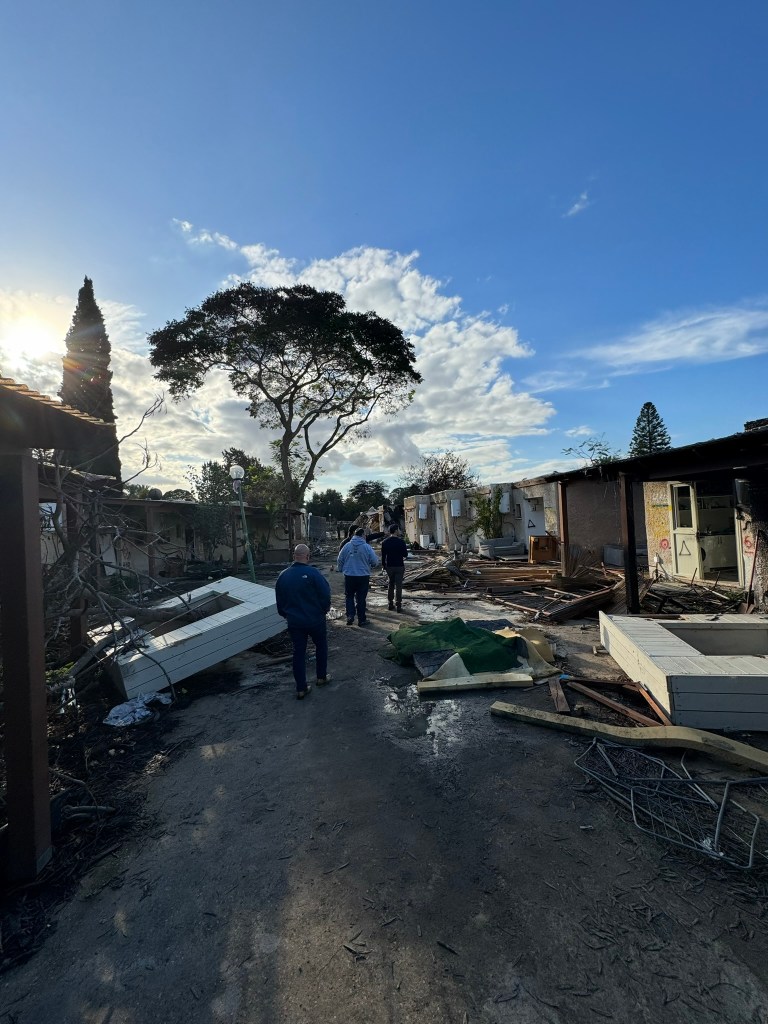

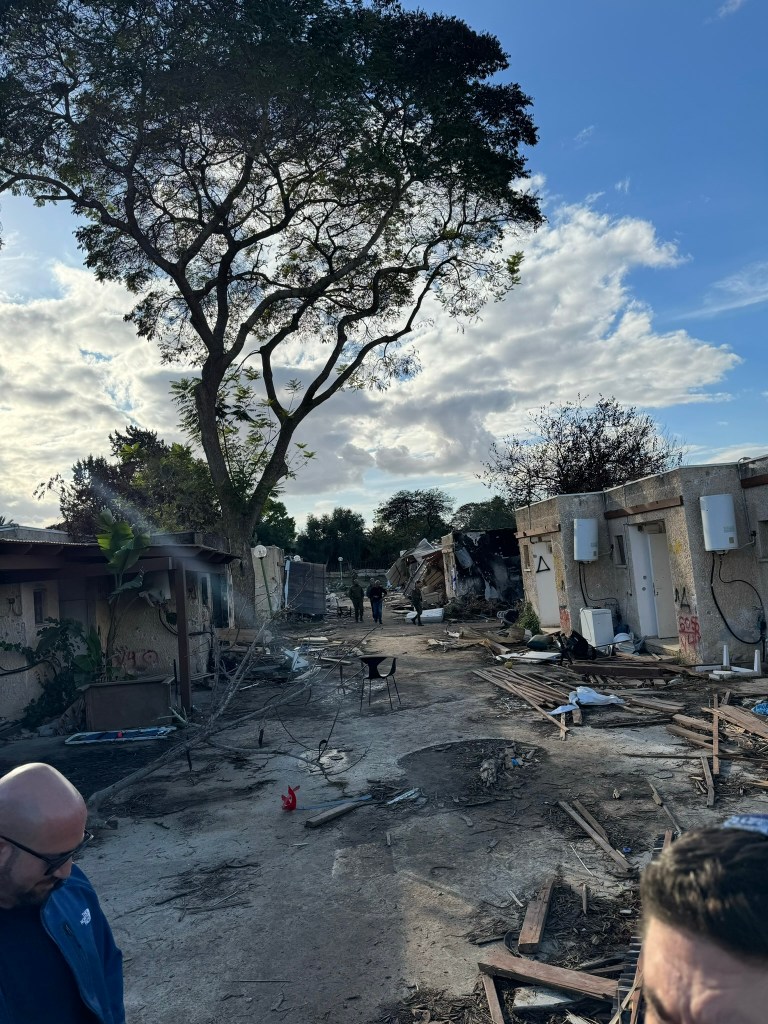





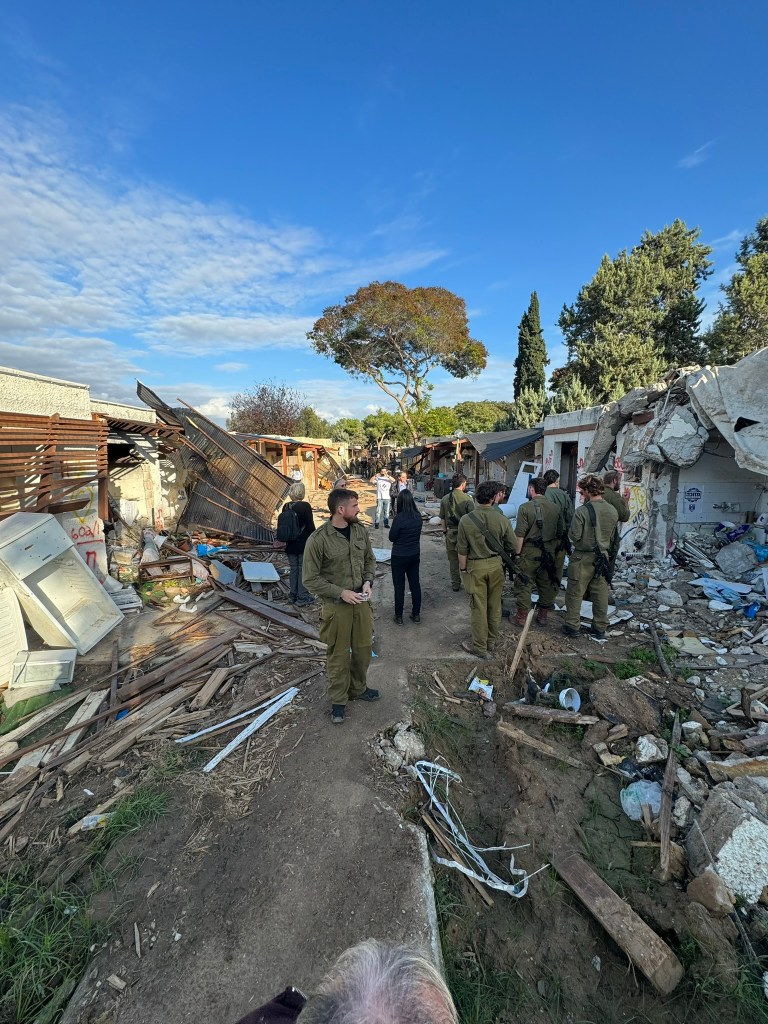

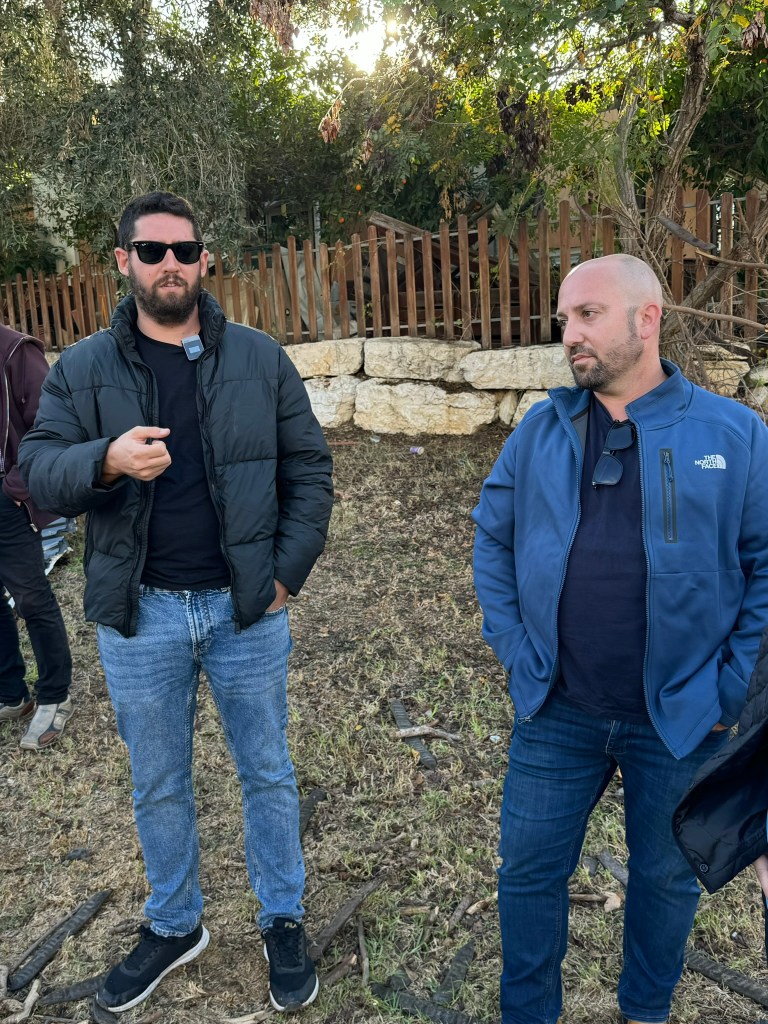










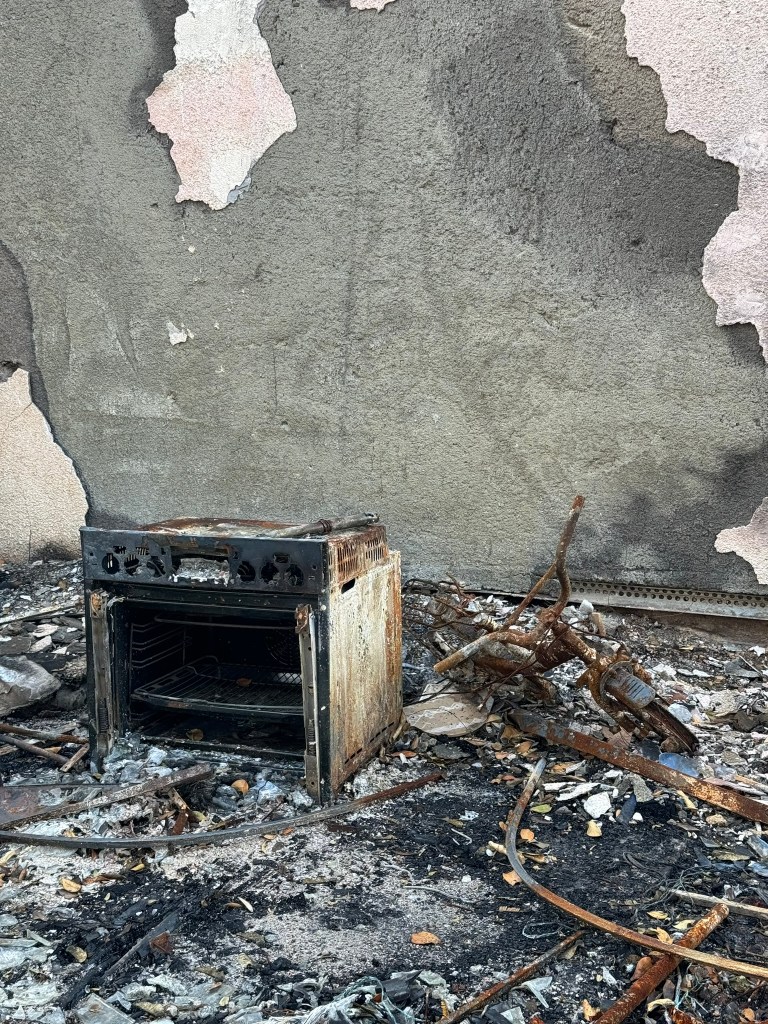

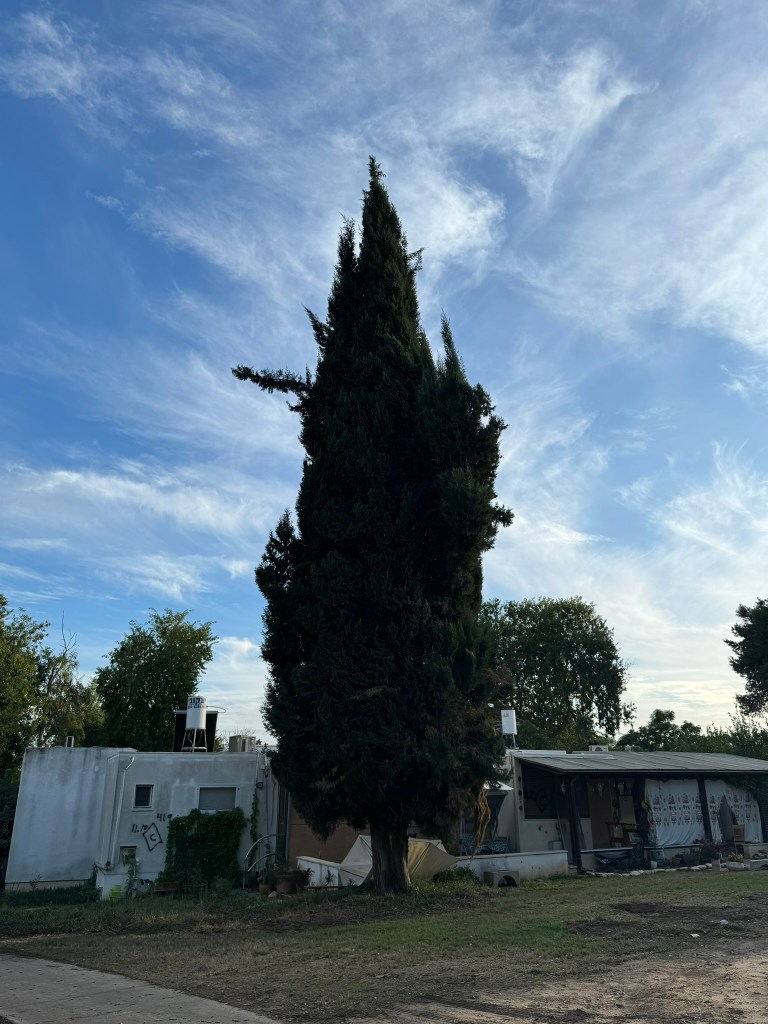
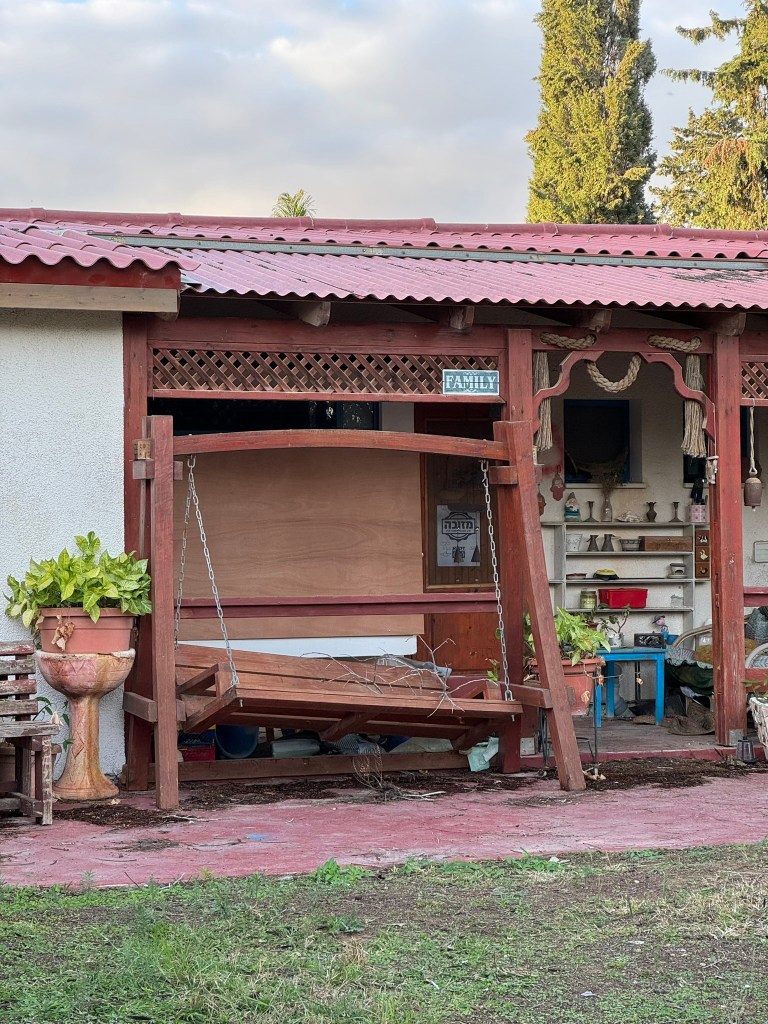
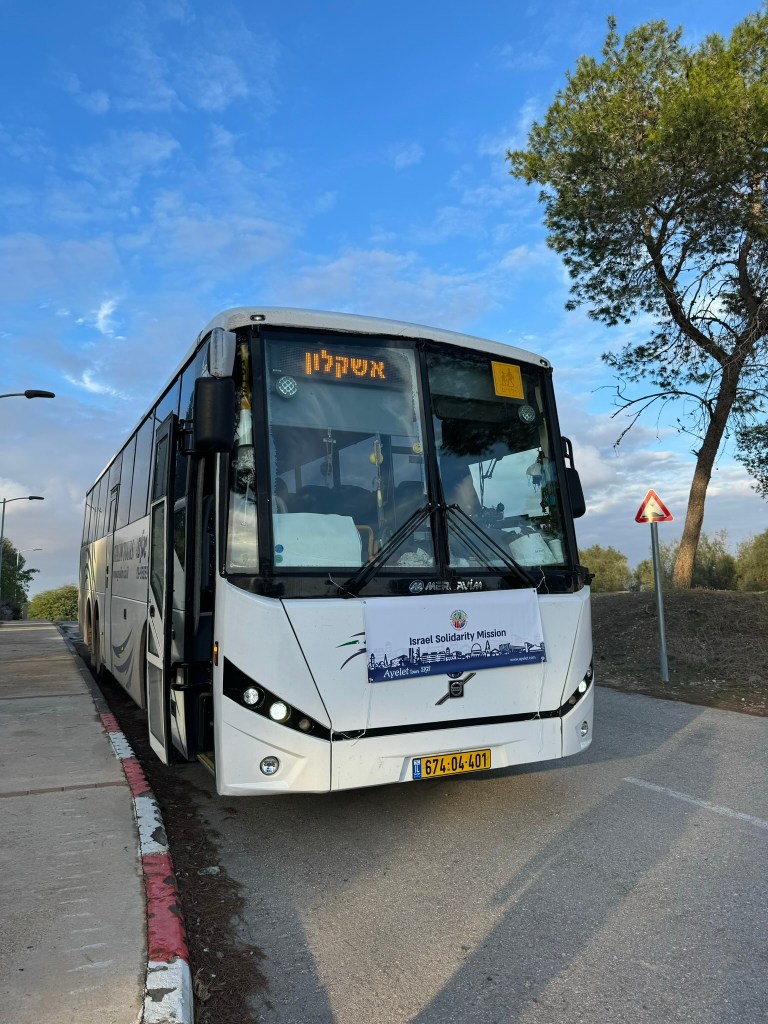
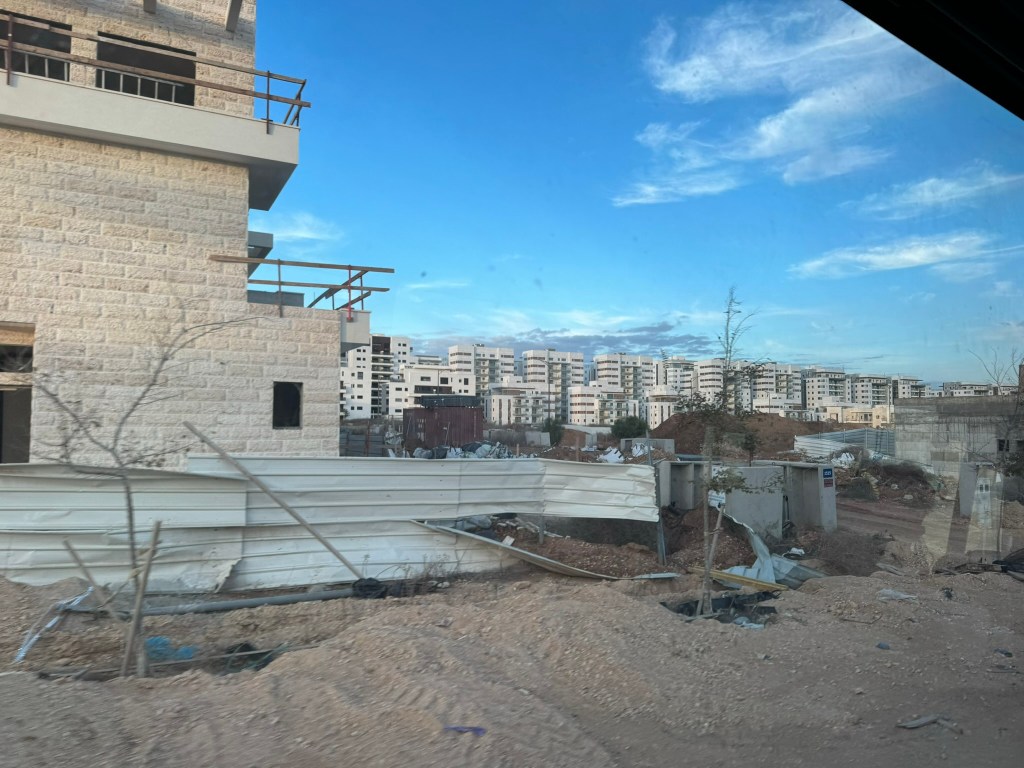




We ask Gon how he can walk around this space, so soon after experiencing this trauma. He says, “Many are not with us anymore. Someone needs to tell the story. And one day, we want to come back here (to live).” Elon futterman- friend of kfar aza and son of Conservative Rabbi Matt Futterman (who will mean shortly) says that there is a line of survivors waiting to tell their story…may there be lines of open minds and open hearts to hear it…
Our last destination before dinner, Ashkelon. We have a short visit with Rabbi Futterman, former counselor to Rabbi Jonathan Lubliner and former rabbi of a community in Ashkelon. We hear from Matt and three other community members. A few takeaways:

- We hear the ongoing narrative of ordinary people doing extraordinary things (also goes to what this government is NOT doing for its people), providing food, shelter and clothing for total strangers; a network of care unlike any we would ever see around the world.
- There are two lenses from which to see this war- the national level of grief/heaviness and the personal level (were YOU there when it happened)
- For context, 3 years ago, Ashkelon had 400 rockets fired on it over a period of weeks. This October, it was over 2000. Jokingly, a member says now with people evacuated it’s easy to find a place to park. But another talks about the jumpiness- when a group of kids heard a plane overhead, they ran to find shelter as a conditioned reflex. He worries about the mortal decision to take a shower when you have 15 seconds to get to shelter.
And yet…they keep on living. Every day, they package 5,000 packages for kids in shelters. The zoom Kabbalat Shabbat services of October are now the in person kiddushes of this past Shabbat (sound familiar). As one describes it, it’s jumping from the frying pan to the fire- there are people escaping TO Ashkelon.
A telling closing to our meeting- they offer support to US. They feel like everyone has their back, but feel sorry for what WE are going through- extra security, having to explain our right to exist!! And if not telling enough, they pitch moving to Ashkelon, the greatest city. Am Yisrael Chai
Cantors Assembly Solidarity Mission Day 3
Our morning begins with a debriefing by Yizhar Hess. Between 2007-2020 Yizhar served as the Executive Director of the Masorti Movement in Israel. Yizhar also coordinated our last Cantors Assembly leadership mission in the summer of 2022 (more on that later). Three major takeaways from our interactions:
Yizhar mentions that we are the 4th Solidarity mission of Masorti (Conservative) leaders since October 7. He reframes the significance of us being in Israel at this moment, our mission, in how it relates to zionism. In 1897, the Zionist Movement was a minority- the first congress only had 207 participants. 1903 the Kishinev pogrom. This wasn’t a large pogrom by any scale, but the key to this moment was that a delegation was sent after the tragedy, a delegation that included the great Hebrew poet Bialik, who wrote Be-ir Heharageh. In retelling the story, it galvanized the Zionist movement. Stories, real life stories, matter to changing the direction of a narrative. We are now associated as tellers of this unbelievable story (remember to believe the unbelievable).
The second update was on Yizhar’s family. He is the only civilian in his family. For his oldest son, one week he was in Nepal, the next week on the beach in Gaza. His younger son is in the IDF and his wife is a colonel in the IDF. Yizhar reminds us that Israel had been in turmoil BEFORE the war- every Saturday night hundreds of thousands protesting in the streets, fighting for that holy balance of democracy and Jewish statehood. And it was through this turmoil that people felt they were protecting Zionism, holding flags, having ownership over what Zionism is.
The third portion, which was the focus of our talks with Yizhar 18 months ago, is the strengthening of the diasporic pluralistic voice of the people. With Mercaz (elections may be in early 2025), American Jews can have a voice 100% by voting for Masorti Mercaz. The PR for Masorti must be this fact and the fact that all of these values people are fighting for- showing resilience in the battle for inclusivity and democratic idealogy, we can be stakeholders, as American Jews, in this endeavor. We can influence how the Gaza envelope will be repaired, how egalitarianism can matter for the Jewish homeland.
We head over to two schools in Jerusalem that now house what’s known as a Hamal, a civilian command center. We meet Adir Schwartz, the 29 year old who is both head of the largest political party in Jerusalem (hitorirut) and the director of this Hamal operation. By the end of October 7, Adir had already plugged in the first laptop on the fifth floor of this building to mobilize a movement. The theater is a newer construction, meaning it has shelters..and soon Adir and his team took over the entire building. Through the organization Lev Echad, this group of volunteers created an organization of 20 departments as they heard the needs of 3 key demographics: the 30,000 evacuees coming to Jerusalem, Soldiers, and the Jerusalem community (some 10,000 will be directly affected by this war). These departments include mental health, storage, transportation (getting out of harms way, delivering food), hot food, blood drives, and so on. Adir also describes the plan to not create dependency – the direct goods and services we are seeing will eventually turn into a voucher system and eventually a discount system before its entirely phased out, b’h, in a few months time.
People want to reclaim their agency, and Lev Echad is helping to do that in a number of ways. The first feeling one can have is powerlessness, but through Hamal, they are able to participate. Adir reminds us that the Hebrew word “Kavod” is not just honor, but human dignity. We see this in a “store” called Otef, meaning “embrace.” It’s a store, but it’s free. The experience returns agency to all who enter.
Adir is quick to thank all of the volunteers. When the government (in this case the municipality) finally came in to help, the volunteers were running the show- they knew what to do, what to ask, what to say; many of them were then hired by the municipality to continue in this role.
On one hand, I hear a common positive theme when Adir describes how all of the rival political movements in Jerusalem joined together to create this movement. Yet on the other side, Adir calls the Hotels in Jerusalem “63 refugee camps with a lobby.” Boredom is the #1 problem for refugees and evacuees…and I don’t hear a complete answer to this problem. For every story of communal resilience, I’m more saddened at the lack of access to services (at least under this current government).
After a short lunch break we head to the Old Train Station for a soundcheck for our concert with Hila Ben David. It was wonderful to have members of my family there (who I had never met before!) and to see my colleagues, Hila, and the band give their all. You could see the joy on people’s faces, and as I remarked before one of my favorite songs, Rikma Enoshit- we are all one tissue: when I hurt, you hurt; when you find joy, I find joy. May we all find joy and comfort in the days. Video forthcoming












And finally, a relief. As we walked back to the hotel, I learned that Amit Shani was released today alongside 11 other hostages. Amit was partnered with our congregation to add special prayers for these past few weeks. In a cruel layer of misinformation, Amit’s information was included in group from a few days ago, but tonight he heads home. We pray until they are ALL home #BringThemHome
Cantors Assembly Solidarity Mission Day 4 part 1
As I was checking in to our midnight flight home, I looked back at my “notes” app to reflect on the day. It was hard to imagine all that we fit in our final day in Israel- the itinerary, the interactions, the emotions. I’m going to try to fit it all into two posts as I sit here in the middle row at 9am (or really now 2am). A note on the photos- they will be a mishmash of happy and sad- of note, I hope that you’ll be able to feel the ways in which Israel and Israelis are trying to process this war, just as I have just started to figure how I process what we’ve seen and experienced.
Israelis keep i24 on all the time- on tvs, on their smartphones. It’s not background noise- it’s the passing of information in real time. In similar fashion I refresh my Times of Israel or Haaretz main page seemingly every five minutes. Immediately following breakfast (sharing a video montage for a little levity),
I read about a terrorist attack in Jerusalem. Within minutes, security footage is posted on X to reveal two Hamas gunmen shooting up a Jerusalem bus stop towards the entrance of the city (they were residents of East Jerusalem, for context). This isn’t near us or our route for the day as we head to Jerusalem, but it is telling that I told my wife all would be ok since I’d be staying in Jerusalem most of the time (and even our friend Eli sent me a note glad that I was heading to Tel Aviv for the day).
We drive to Tel Aviv en route to Ichilov hospital, the 2nd largest hospital in Israel (also where my cousin Aton Holzer, who I’ve never met, works as a dermatologist -note he is actually out of the country this week!). En route, we discuss some of the updates we’ve been reading and hearing about on the news- hostages held in the homes of physicians and UN personnel, Thai workers testifying that the Israelis, and just the Israelis, who were held with them, being beaten with electrical cables; the misogyny of Israeli intelligence, as a number of female intelligence officers warned of an impending attack only to be dismissed by higher ranking officials; the PR war-Hamas as the one who delivers by attacking Israel and bringing home their imprisoned, while Fatah is all about corruption.
At Ichilov, we meet with the rabbi of the hospital, Rabbi Avraham, who gives us a brief outline of his role as pastor and chief rabbi. Most of the questions he fields are about “kashrus,” as the one who oversees 10,000 kosher meals a day. The most important part of his job is dealing with the ethical issues that come up- this can be a case by case basis, and it can also be how he uses the weekly torah portion to help inform an ethical standard of practice for all the physicians and social workers who work with patients-just thinking of this week’s parsha, when Jacob splits into two camps for fear his brother will kill them all- it’s a story of triage.
I think our delegation of hazzanim is a bit of a shock to the rabbi. Not only are we (men and women) serving in a full time capacity, but our pastoral presence in our communities- visiting congregants in elderly care facilities, hospitals, in trauma, is a different model than in Israel- synagogue clergy rarely visit their members in hospitals. It’s an important realization on his part as we prepare to visit soldiers injured on October 7.
Most of those injured on October 7 went to other hospitals, but over the past few weeks, a number were transferred to Ichilov who required more surgeries and a different level of care. At first, this feels very different from our straight off the plane visit to Hadassah hospital. The first soldier we meet is very matter of fact (we understand that for some, sharing their story is therapeutic, but that’s not the case for everyone): 2 bullets to his shoulder. We learn from others in the room that 18 of the 28 members of his unit were killed, simply unimaginable.
We meet with Yaron, a resident of Kfar Aza. To hear another layer of the story we had heard and seen on Tuesday was powerful. Yaron’s ex wife, along with one of their 3 children, were in Kfar Aza when the ambush began. The two held off for 22 hrs as Hamas gunmen shot at them from their roof. Yaron heard about the attack right away and came INTO Kfar Aza to help. He was shot with an RPG like rifle (something he says he has never seen before). Yaron laid there for 3 hrs before being rescued. He was in a coma for 2 weeks and lost part of his lung. In reflecting on that morning, Yaron speaks of the “beautiful people we lost,” a reminder of the lives, innocent civilian lives, that were cut short by monsters.
Our group gathers in an open space in the rehab floor to sing a number of songs, including the now canonized Acheinu prayer that speaks of the bonds of brotherhood and the need to bring everyone from darkness to light, from captivity to freedom. As we close, a soldier shares that he’s thinking of us during this difficult time in America. He also reiterates an important message that there are different ways to help. For him, having us sing for the patients and their families makes them stronger. Two of us begin a conversation with a mother (originally from Rochester, NY) who waits for her son to return from his IV treatments- he was bartending in Miami Beach just before the holidays, only to return home, enlist, and experience major injury. We added his name in Hebrew to our mi shebeirakh prayers.
After lunch at Serona Market we will make our way to two places where families, friends, and all of Israel come together to shout out Bring Them Home Now. Closing reflections coming soon








Cantors Assembly Solidarity Mission Day 4 & Closing thoughts
Day 4 and Concluding reflections
The remainder of our last day in Israel focuses on the hostages and their families. First, we visit the Hostage and Missing Families Forum, known through the hashtag #BringThemHomeNow. According to their website, the Hostage and Missing Families Forum was formed by the families of the abductees less than 24 hours after the horrific attack by Hamas on Israel on October 7th, in which more than 1300 innocent civilians were murdered and hundreds were taken hostage. The Forum is volunteer-based and laser-focused on bringing the hostages back home to their families, to us.





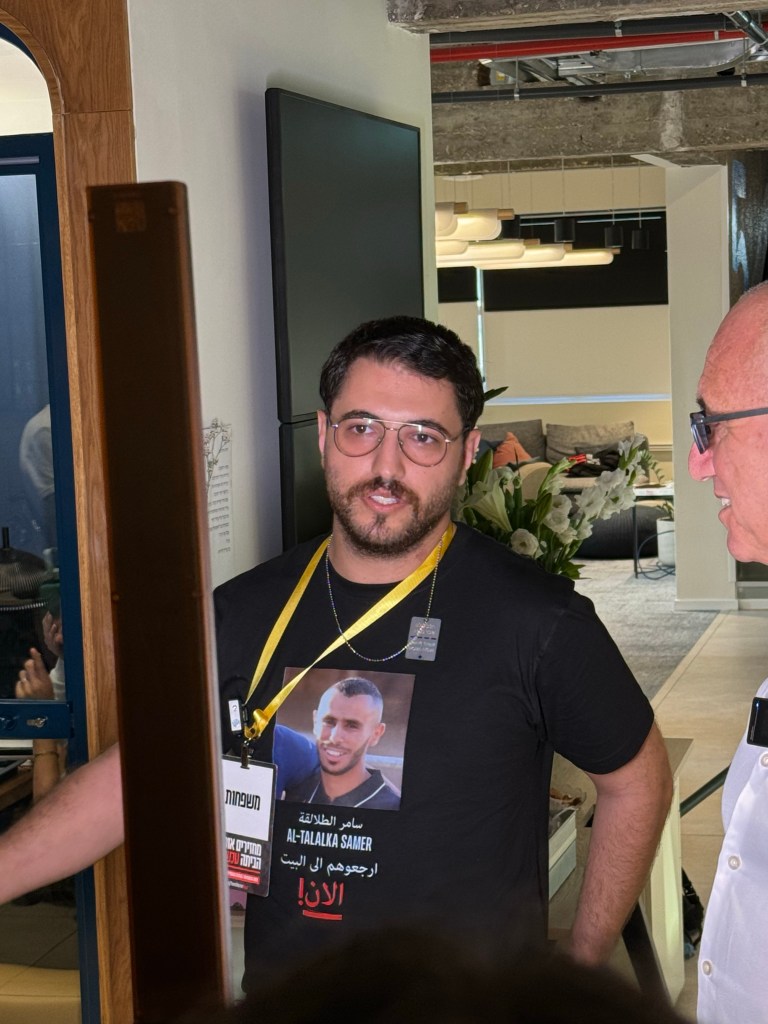




Our guide Meirav reiterates the volunteer nature of this NGO as people work around the clock in addition to, in many cases, full time jobs. The two goals are to keep the return of the hostages in the forefront of the political agenda as well as supporting the families of the hostages. We meet members of a number of the teams- the diplomatic team mobilizes awareness in their own governments, the medical team provides mental health resources for families and supplies medical info of the hostages to the Red Cross, whom Meirav describes as acting like a GETT taxi driver, refusing to offer medical attention when needed; the legal department, communication department (think of all the billboards in 90 locations around the world); the social media team who write everything in Hebrew AND in English; and the influencer department, where we learn from Brian Spivak (originally from Englewood, NJ) who works with creators and influencers to share stories about the hostages- one such example is the “recipes4return” campaign on Instagram where food bloggers make recipes while sharing stories of the hostages. We learn that the color scheme of the posters, often in the jarring black, white and red colors, now includes a yellow ribbon inspired by the yellow ribbon campaign for veterans, here in the US.
After the terrors of October 7, Dudi Zalmanovich, a prominent Israeli businessman whose daughter survived the massacre at the Nova festival and whose nephew was taken captive by Hamas, emptied two floors of his office and gave birth to the forum. We hear Dudi speak about the days immediately after and how the forum is adapting to the reality of some hostages being released. A number of times, he says that doesn’t matter Israeli or non-Israeli, Jewish or not Jewish, they want all of the hostages home safely and home speedily. After we sing a very emotional Acheinu (a literal prayer for hostages) in our little hallway, Dudi’s statements come into play in real time, as a family member receives a phone call right next to us that Aisha Ziyadne, from the Bedouin community of Ziyadne, is one of the captives being released (if you’re thinking Bedouin – a reminder that Hamas doesn’t want people of all religions living on this land). Later that night, we learn that her brother Bilal is also released. After an embrace, As Dudi puts it, “to see this person so drained yesterday and now today…” Even in the joy of the moment, the shirt he wears reminds us that there are still other family members in captivity.
After picking up posters and t shirts to bring back to the states, we make our way to what has been renamed Hostage Square. I’ll let the images speak for themselves, as artists and family members find a way to express their sorrow, their pain, and their hope, all in one instant. I think of the end stages of life: this is a hospital visit, shiva home, and living monument all wrapped into one. Just as in a shiva home, we are told not to start asking questions or talking too much when we interact with families of the hostages gathered in the tents. If they want to talk, they will initiate. I listen in on a conversation with the aunt and uncle of hostage, Elkana Bohbot. With everything going on, life being a blur and in many ways halting on October 7, it was comforting for me to hear the two of them laugh with friends, even for a short moment. Normalcy is something we all crave.
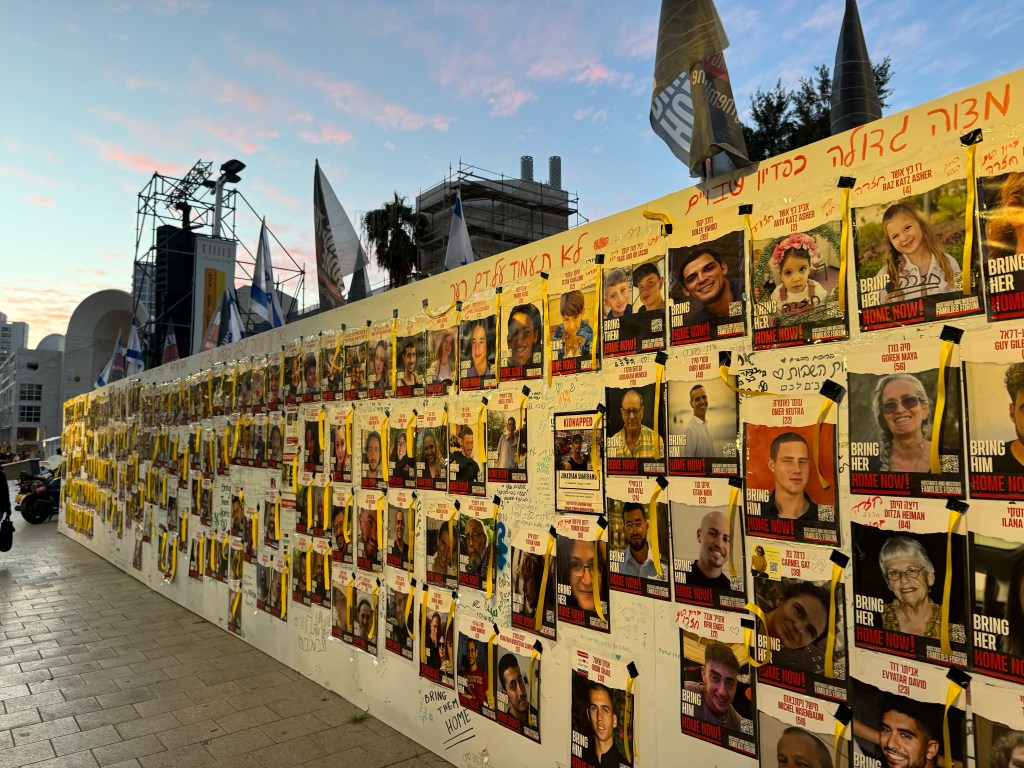




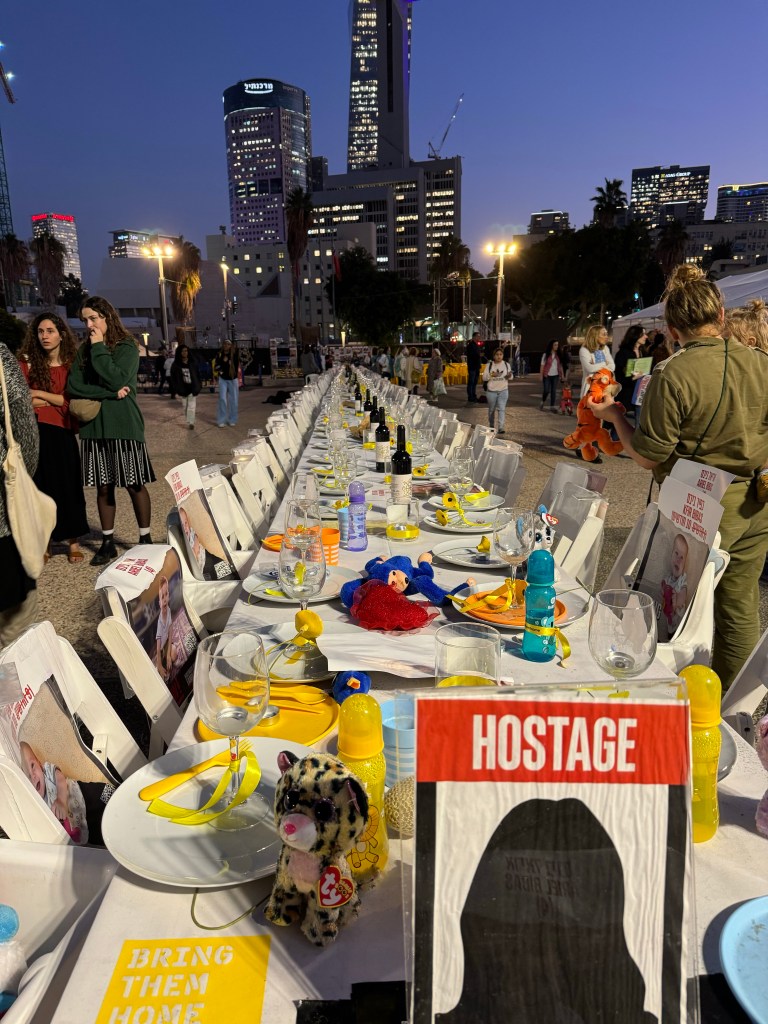
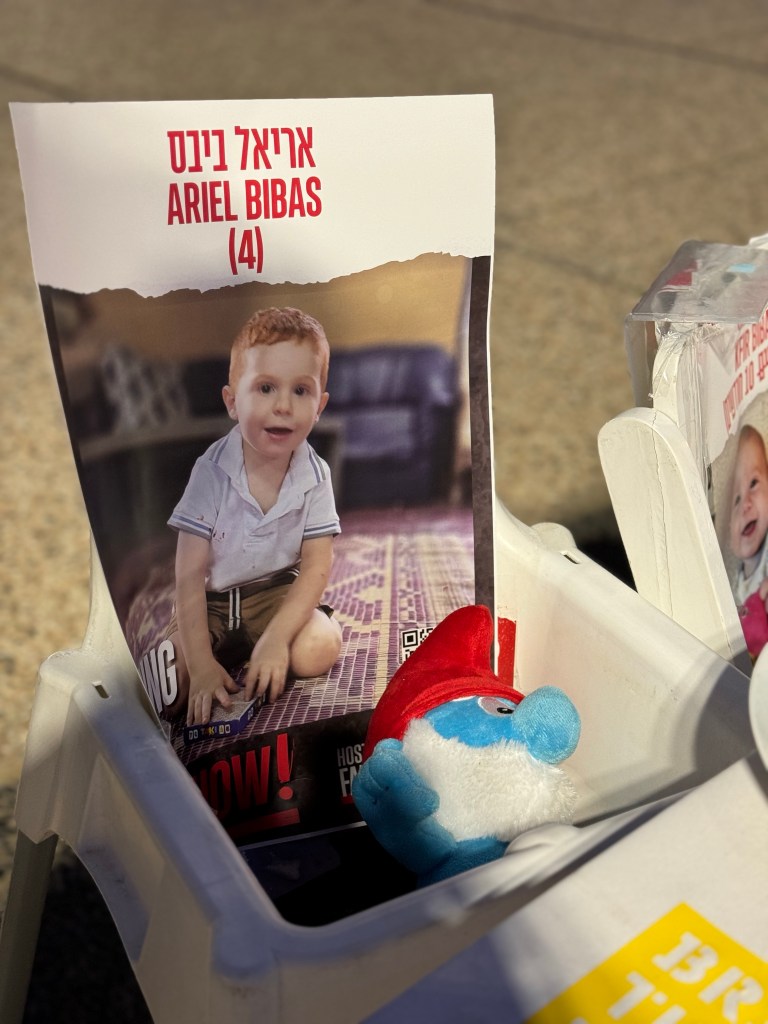











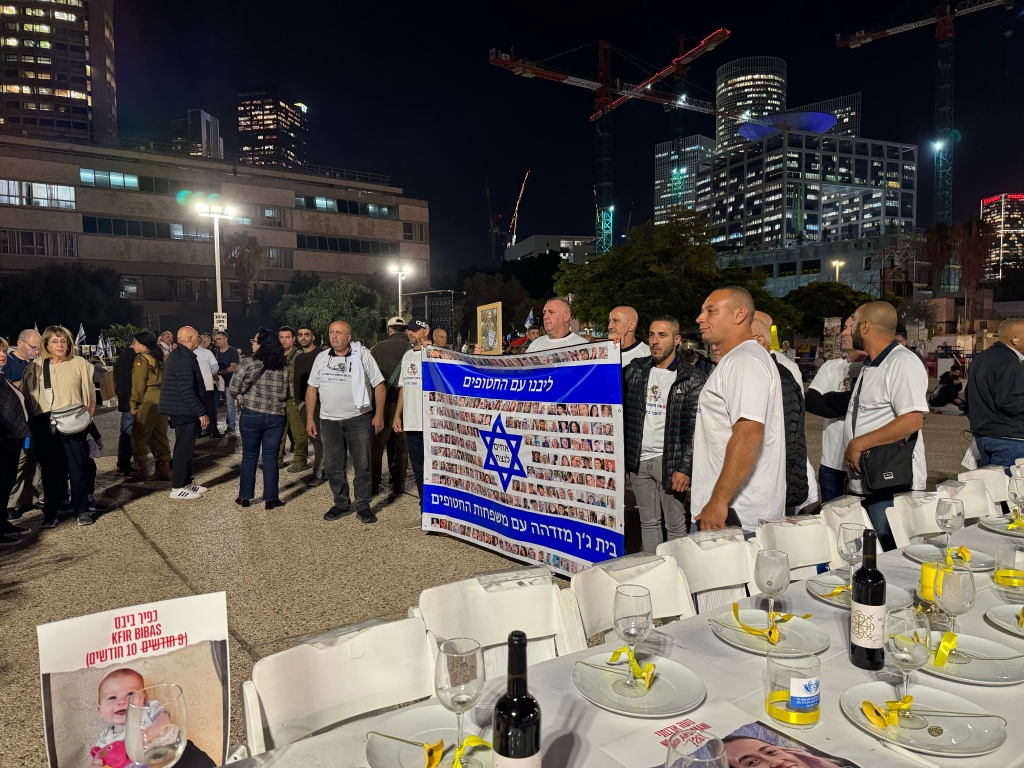

Everyday at 5pm, community members gather in the square for prayers and shira b’tzibbur, communal singing. We were privileged to help lead this ceremony, with our instruments, our voices, and our fullest kavanah. More than singing at the hospitals (often singing “to” the families), this was a spiritual communal moment when everyone was singing. It was nice to see our Masorti counterparts and other friends visiting from North America.
Our final dinner at an amazing restaurant, Goshen (photos included), was a way to express gratitude to our guide Kari, our producer Ben, videographer Or and all of our colleagues for experiencing the power and difficulty of this mission, together. As we shared words around our table, it also helped me to begin to formulate the narrative that I hope to share with all who read.


As I write this last post, the mood is changing in Israel. Hamas breaks the ceasefire by firing into Israel, by not sending a new list of hostages to be released. Yes, the 7 day ceasefire that saw over 100 hostages released, that had enveloped our entire 5 day journey, is over. It makes this experience unique, an ענין של זמן , a moment in time.
As the psalmist writes in psalm 121,” the guardian of Israel neither slumbers nor sleeps.” Israelis, the literal guardians of Israel, neither slumber or sleep. The resilience of this country is unbelievable- believe the unbelievable, as I mentioned early, can be a positive too. I pray that there are pockets of relief, followed by blankets of joy in the days ahead. While this is an indictment of Israel’s government, the intestinal fortitude of each Israeli to push on, to have open hands and hearts to family and strangers, is something we on this side of the Atlantic can learn a lot from. Israel mobilized, and we CAN do the same- for our own communities and for the state of Israel.
In the complexity of sadness & joy in every moment, an image is engrained in my mind- that of the tall Cedar trees that we found in Tel Aviv, in Kfar Aza, in Ashkelon, in Alumim, in Jerusalem. Cedars that stand tall even in the midst of chaos. Just as we speak of the inhumanity of Hamas, we MUST speak of Israeli expressions of humanity. Facts and figures are important, but human touch points will be what is needed to change the narrative.
When our group shared those last moments of gratitude, our videographer Or (you’ll see his work soon thanks to funds we raised at the JJC), said that WE are the hope. WE, the cantors on this mission, and WE Israel’s family and friends in the diaspora. This isn’t something Israelis would’ve said two months ago…
As we often have had a shaliach (emissary) with us in Jacksonville, I’ve never felt more of a shaliach representing and strengthened by you. The messages on Facebook, and in particular a video my daughters made with their cast of Newsies (shared later), have brought me to tears when I’ve felt overwhelmed. Being in Israel, sharing music, stories and lots of hugs, has been the language that pierces the heart and soul. Together, Israel and diaspora, are the hope. Just as we can have boundless love, we can always have boundless hope- hope for the return of hostages, for peace, for a people of Israel that thrives for generations to come. Am Yisrael Chai
When a fortress is also an open tent
Parshat Vayeira begins with the following story:
God appeared to him by the terebinths of Mamre; he was sitting at the entrance of the tent as the day grew hot. (2) Looking up, he saw three figures standing near him. Seeing this, he ran from the entrance of the tent to greet them and, bowing to the ground, (3) he said, “My lords! If it pleases you, do not go on past your servant. (4) Let a little water be brought; bathe your feet and recline under the tree. (5) And let me fetch a morsel of bread that you may refresh yourselves; then go on—seeing that you have come your servant’s way.” They replied, “Do as you have said.” (6) Abraham RAN into the tent to Sarah, and said, “Quick, three seahs of choice flour! Knead and make cakes!” (7) Then Abraham ran to the herd, took a calf, tender and choice, and gave it to a servant-boy, who hastened to prepare it. (8) He took curds and milk and the calf that had been prepared and set these before them; and he waited on them under the tree as they ate.
Abraham offered morsels of bread and a little water. He returned with a feast- cakes, meat, and milk. It’s also the first example of chutzpah in the bible, as he really gets others (Sarah/servant boy) to do the bulk of the work while he does the running. Collectively, that’s the power of audacious hospitality.
The Babylonian Talmud (Shabbat 127A) relays the following discussion:
Rabbi Yoḥanan said: Hospitality toward guests is as great as rising early to go to the study hall…And Rav Dimi from Neharde’a says: Hospitality toward guests is greater than rising early to the study hall…Rav Yehuda said that Rav said on a related note: Hospitality toward guests is greater than receiving the Divine Presence, as when Abraham invited his guests it is written: “And he said: Lord, if now I have found favor in Your sight, please pass not from Your servant” (Genesis 18:3). Abraham requested that God, the Divine Presence, wait for him while he tended to his guests appropriately.
Welcoming others into our tent comes first, even before welcoming God.
Looking at our own community- how can we show acts of audacious hospitality- to those we know, and those we might not know?
It was back in February of 2009, roughly 15 years ago, that our Safer Shabbaton Scholar-in-Residence was Dr. Ron Wolfson, professor at American Jewish University and author of a recently penned book entitled “The Spirituality of Welcoming: How to Transform Your Congregation into a Sacred Community.” Using his research as our guide, our board and staff at the time began exploring best practices and what might prevent us—as individuals or as a community—from being fully welcoming?
Greeter training, better signage, colorful handouts, transliteration guides, come as you are, our doors are always open… A number of great ideas came from out of this Shabbaton. Some ideas were implemented, but with the passage of time, many of them were not – staffing and budgetary constraints, or conflicting ideologies (imagine someone being interested in a Green initiative while also printing hundreds of Shabbat handouts each week) played a factor. But in reality, the world changed a few times over. The board of directors (none of whom are the same from 2009), the professional staff (only 2 remain), and even the shabbat regular crowd (most of you weren’t shabbat regulars here at the JJC in 2009), is a different makeup from 15 years ago. We are the same synagogue, but we aren’t the same group of people that filled these pews back then.
That being said, there were four events that changed the trajectory of how we welcome people into our community.
When you enter our building, you’ll notice a large “Stand with Israel” banner created in the summer of 2014, following the kidnapping and murder of three Israeli teenagers in the West Bank, leading to the 2014 Gaza War. It was in its aftermath that we began to add more security measures than ever before.
5 years ago, the brutal murder of 11 souls at Tree of Life, meant a full time security staff; more training, cameras, and other security measures. It’s the reason I wear a smart watch with SOS capabilities. This is the new normal.
2020. Covid taught us about protecting each other; we returned to worship with no shared kippah bins or shared scarves, but rather with hand sanitizer and masks; we balanced the hybrid of welcoming those in person while trying to maintain a welcoming atmosphere online (often leaving both parties wanting something different), and as we emerged from that point to recognize the concept of mitigated risk- we can never prevent everything from going wrong, but we can be more mindful of how to prevent further harm.
And almost one month ago. Israel is at war with terrorist monsters. And we are broken, scared, and uneasy.
All of this has meant that we, collectively, have had to recalibrate the art of welcoming. And for November 2023, in this moment at least (or in the moment I wrote this sermon) it seems like I am consumed with the feeling, that this is a place, this is a safe space for Am Yisrael Chai; a feeling that every Shabbat, here, is solidarity Shabbat, and that is a very welcoming feeling to me, the not so outsider of this congregation. And I want to go into that for a minute.
Back in March of this year, I led a caravan of baseball loving, Israel supporting fans to a South Florida pilgrimage- Ben’s Deli, and a World Baseball Classic game of Team Israel vs. Team Puerto Rico. As I stepped onto the shuttle bus to the stadium, wearing my kippah and a personalized Israel soccer jersey, a large blue star draped in the front, the Puerto Rico fans on the bus jokingly booed- not because of my kippah, or my Jewish heritage, but because I was the rival team in a baseball game. I thought “wow, we’ve made it- maybe things are turning around in this country.” On October 8, following the events of the previous day, I wore the jersey walking to synagogue, with pride, and without fear. By October 10th, those feelings of safety dissipated. I wear my Israel gear to the JCA, to synagogue, but nowhere else. When I went to a Pro-Israel rally downtown, I wore a baseball cap. I pray that my fear will subside, but for today, this synagogue is that haven, that refuge where I can express my Judaism fully, and safely; a place where we pray for our ancestral homeland and recognize it’s right to exist and defend itself. This is what welcoming means to me, today.
And for those who wear your blue ribbon outside of this space, who hang their Israeli flags, thank you for being brave to extend the openings of this tent to more dialogue and understanding. Last year, when buildings downtown were desecrated by projections of hate, we countered with projections of love. And I hope I’ll join you soon, maybe I’ll be ready in a month, when it’s time to inflate my dozen or so Hanukkah inflatables on my front lawn overlooking Scott Mill Road.
When we have this laser, singular focus on Israel, I don’t want to forget that our synagogue is so much more than a haven from the darkness that surrounds us. We may never construct a perfect setup that makes every person feel safe, or welcome, but as we aim for that as our goal, as we pray not only for wholeness and peace in the world but wholeness of an inclusive community, the onus is on the jew in the pew– often sermons we say we are preaching to the choir- but here, you are the choir, the conductor, the instrumentalist, and the soloist to make this happen.
I think about a story about the residents of ancient Jerusalem portrayed in the midrashic work Avot de-Rabbi Natan.
When the Temple still stood in Jerusalem, that city was the destination of pilgrims from throughout the Land of Israel at the three harvest festivals. The rabbinic storytellers of late antiquity relate that Jerusalem’s residents opened their homes for free to those visitors. “No person ever remarked to another, ‘I couldn’t find a bed to sleep on in Jerusalem.’ No person ever remarked to another, ‘Jerusalem is too small [i.e., crowded] for me to be able to stay over there’”.
We see the remarkable spirit of the people of Israel today, in our ancestral homeland, as thousands of displaced Israelis are absorbed by other communities- creating makeshift schools, community centers, homes. I read an inspiring story about a group of adults and youth from the Masorti Kibbutz Hannaton and its surrounding Palestinian and Jewish villages, who gathered yesterday morning to paint signs that read, “Good Neighbors Also in Difficult Times” in both Hebrew and Arabic. They hung them on the main roads in the area and at the entrances to their villages. If they can have an open tent, having the courage and compassion, the knowledge and self-awareness, to honor diversity, to embrace the simple notion that we all belong here, then why can’t we do a few small steps towards the same goal?
We can be welcoming, and we can reach the next level of being inclusive. We can be welcoming, and we can make people feel a sense of belonging. How? At our synagogue, can everyone walk in and not be seen as an outsider, not be seen as exotic, not worry that they will be treated unkindly because of the color of their skin, that they and their families are seen as members of the Jewish community?
Yes these are questions that we must always be asking ourselves:
Do we greet people with questions or statements like:
- “So, how are you Jewish?”
- “Where are you from? No, where are you really from?”
- “You don’t look Jewish.”
Do we hear ourselves or others using these amongst a host of other microaggressions?
How do we welcome the convert? Those interested in conversion? The non- Ashkenazi?
I know I’m guilty at times of a number of microaggressions.
What about the questions that come our way- whether asked out loud or internally?
For Disability accessibility:
- How have you welcomed families with disabilities in the past?
- Are your facilities accessible for folks with disabilities? Is there access to the bima for those with mobility issues (i.e.: folks with a walker, cane or wheelchair)? Do you have large-print prayer books?
For Interfaith inclusion:
- Will my partner, who is not Jewish, be allowed on the bima during our child’s bar mitzvah?
- Will my partner, who is not Jewish, be a welcome addition to the synagogue during events or services that I cannot attend?
For LGBTQ Inclusion:
- Do your membership forms utilize inclusive language?
- Do you celebrate LGBTQ Jewish heroes in your religious school? Has your rabbi spoken about LGBTQ inclusion and acceptance during sermons?
For those with sensory issues: have we considered many aspects of a service that can be overstimulating for different people? Do we offer a space that’s scent free, has comfortable seating options, limits the # of attendees or encourages people to take breaks?
After Shabbat, I’ll be sharing links to a number of these sites- 18doors, URJ, Sensoryfriendly.net as a starting point to doing a little Heshbon Hanefesh, looking inward to how each of us can be more inclusive, more aware of what we say and how we act. I have no expectation that each of us will suddenly be the extroverted greeter who brings everyone into the tent, but it can mean an extra hello, a smile…I can do better, we can do better. Yes there are more questions than answers, but I hope that each of us heeds the call of Abraham from our parsha- Hineni- here I am- I don’t have the answers, but I am here, present, prepared to do the work; I am here to welcome the stranger and the estranged the newcomer and the frequent flyer; to get out of my comfort zone without feeling unsafe, to welcome an inclusive environment despite the challenges of our time. We don’t feel safe, but we can still feel the sacred obligation to welcome all into our tent. Kol Yisrael Areivim zeh Bazeh. All Jews are responsible for one another- to help build, bond, and belong to one sacred community. Shabbat Shalom Umevorach- may we all enjoy a shabbat of peace and blessing.
https://www.sensoryfriendly.net/how-to-make-your-synagogue-sensory-friendly/
https://urj.org/blog/welcoming-vs-belonging-key-step-making-our-communities-diverse-and-whole
Can I get an Amen??
What if there was no sermon this Shabbat? Can I get an Amen? (Loud Amen)
Sorry to those who responded with Amen.
Deuteronomy 27 paints the following scenario:
(11) Thereupon Moses charged the people, saying: (12. After you have crossed the Jordan, the following shall stand on Mount Gerizim when the blessing for the people is spoken: Simeon, Levi, Judah, Issachar, Joseph, and Benjamin. (13) And for the curse, the following shall stand on Mount Ebal: Reuben, Gad, Asher, Zebulun, Dan, and Naphtali. (14) The Levites shall then proclaim in a loud voice to all the people of Israel:
(15) Cursed be any party who makes a sculptured or molten image, abhorred by יהוה, a craftsman’s handiwork, and sets it up in secret.—And all the people shall respond, AMEN (16) Cursed be the one who insults father or mother.—And all the people shall say, AMEN. (17) Cursed be the one who moves a neighbor’s landmark.—And all the people shall say, AMEN. (18) Cursed be the one who misdirects a blind person who is underway.—And all the people shall say, AMEN. (19) Cursed be the one who subverts the rights of the stranger, the fatherless, and the widow.—And all the people shall say, AMEN. (20) Cursed be the [man] who lies with his father’s wife, for he has removed his father’s garment.. —And all the people shall say, AMEN. (21) Cursed be the one who lies with any beast.—And all the people shall say, AMEN. (22) Cursed be the [man] who lies with his sister, whether daughter of his father or of his mother.—And all the people shall say, AMEN. (23) Cursed be the [man] who lies with his mother-in-law.—And all the people shall say, AMEN. (24) Cursed be the one who strikes down a fellow [Israelite] in secret.—And all the people shall say, AMEN. (25) Cursed be the one who accepts a bribe in the case of the murder of an innocent person.—And all the people shall say, AMEN. (26) Cursed be whoever will not uphold the terms of this Teaching and observe them.—And all the people shall say, AMEN.
Before 92,003 attendended a Nebraska womens’ volleyball game or 109,318 attended a Michigan Wolverines football game, this was the ultimate crowd event, a great moment of theater. In this corner…Simeon, Levi, Judah, Issachar, Joseph, and Benjamin…and in this corner Reuben, Gad, Asher, Zebulun, Dan, and Naphtali.
This is one of two sections in the torah that we call “the curses,” but when you hear it recited out lout, it really could be called the “amens.”
So as luck would have it, in thinking about the power of amens, and in figuring out this sermon yesterday afternoon, I luckily had a fantastic teaching from Rabbi Elie Kaunfer of Yeshivat Hadar in my email inbox from just a few days ago. We love Hadar’s weekly Dvash Parsha magazine , so why not utilize their torah teachings for this week’s portion. So I thank Rabbi Kaunfer in advance for taking over the next few paragraphs:
The use of “amen” in our parashah lays the groundwork for meaning #1: accepting the consequences of a statement. In Parashat Ki Tavo, Israel is accepting upon themselves the consequence of not following various laws (being cursed). R. Yosi bar R. Hanina, therefore derives from this scene in the Torah that one general function of reciting Amen is kabbalat devarim, accepting the consequences of a statement.
The word amen has two other meanings in prayer, beyond acceptance of a consequence. Meaning #2 is to express agreement about something that has happened or is currently the case. In this way, amen is similar to emet, meaning: I affirm what was said is true. Meaning #3 is to express belief in something that will happen, but has not yet come to fruition. This is also a form of request: I hope that this will happen. Here, the tradition that amen (אמן ( is an acronym for the statement: “אמן נ לך מ ל -א – God the king is trustworthy,” and will act in the future, is particularly resonant.
But the word “amen” is not limited to its meanings: it also has a role and function in ritual performance. The Mishnah describes the performative element of the amens in Parashat Ki Tavo: Mishnah Sotah 7:5
They turned their faces to Mount Gerizim, and [the Levites] opened with a blessing… and both groups of Israelites [standing on both mountains] answered “amen.” Then they turned their faces to Mount Eval, and [the Levites] opened with a curse… and both groups of Israelites answered “amen,” until they had finished [reciting and responding to] the blessings and curses. (Note that the Mishnah assumes all the Israelites said “amen” to the blessings, not just the curses, even though in the Torah itself amen is only explicitly recited in response to the curses.)
This is a moment of deep symbolism, in which one mountain (Gerizim) represents the potential blessings, while the other mountain (Eval) represents the potential curses. When the Levites face each mountain in turn, they are directing their focus to the blessing or curse embodied. The people on the mountains provide the ritual response of the blessing or curse with their response of “amen.” The “amen” recited by the people, over and over again, is not only an indication of their acceptance; it is also a public ritual that elevates the moment. Imagine the power of hearing amen again and again, recited by the entire people, at each stipulation of the covenant. It is a powerful image of a group of people focused on words and responding with agreement and acceptance.
This is the power of Amen:
Talmud Bavli discusses the importance of “Amen” in tractate Berakhot 53b:
R. Yose said: Greater is the person who answers “amen” than the person who recites the blessing. R. Nehorai said to him: By heaven this is so! Know that this is true, as the military assistants descend to the battlefield and initiate the war, but then the military heroes descend and prevail.. Aer R. Yose claims that the one who recites “amen” is greater than the one who triggered the recitation with a blessing, R. Nehorai attempts to explain this with a parable: the one who recites the blessing is simply preparing the way for victory. It is not until the appearance of those who recite amen that victory is assured”
Thus begins the origin story of the phrase, “Can I get an amen?” Blessings, even curses are a contract between the one blessing and the one hearing the blessing. There is no given that an amen will come your way. As we think of our bar mitzvah this morning- many of the major moments of Bar Mitzvah- the torah blessing, the haftarah blessing, are moments in which the kehillah, the congregation, responds verifying the eligibility of said blesser and affirming that they can be that shaliach, that emissary for all of us in the giving of the blessing.
Last Shabbat, our city was in the national spotlight following the brutal murder of Angela Michelle Carr, Jerrald Gallion, and Anolt Joseph Laguerre Jr by a racist white supremacist, radicalized by hateful rhetoric.
The next day, I found myself downtown for a trio of events- The first two taking place at the Jessie downtown. THe first was a meeting of Jacksonville leadership spearheaded by Rudy Jamison, Jr., who now serves as the Executive Director of the Jacksonville Human Rights Commission. Following the meeting, a program (already on the books) marked the 63rd anniversary of the Jacksonville Youth Council NAACP 1960 Sit-ins and Ax Handle Saturday The program was led by activist Rodney Lawrence Hurst Sr and attended by our Mayor, the first time a mayor of Jacksonville attended such a commemoration in, well, 63 years. And finally a prayer vigil organized by Councilwoman Ju’coby Pitman and our Mayor. The bulk of the vigil, attended by New Town residents, members of the Jewish community, elected officials and more, was a place where many came to grieve, to share their frustrations, to pray. In fact, it was noted that before the 15 or so clergy spoke, they were told to “pray, not preach” for two minutes each. And throughout all these experiences, I listened. Yes, I heard anger, I heard “Jesus” mentioned once or twice, but I also heard “Amen” or rather “Can I get an Amen” throughout each prayer offered. And speaking in the vernacular and in the language of prayer, the “Amens” stood out. Those who offered an “Amen” knew what they were Amen-ing. And even if I as a Jew wasn’t always ready to Amen every blessing offered, I understood the blessing being offered, the power that the collective held in offering a congregational “Amen” and the power of those who offered prayer as a vehicle for change.
And I thought to myself:
How can we as individuals, as a collective, be better equipped to offer “Amen,” as Rabbi Lubliner often says at the end of a service with a Bar/Bat Mitzvah, a “heartfelt amen”? As outlined before, Amen means a number of things:
Amen means understanding; literally. To know what we are Amen-ing
Author and Liturgist Rabbi Lawrence Kushner, in an interview with Rabbi Mike Comins, author of “Making Prayer Real” explains the following:
I hear people say Hebrew is a barrier, or it’s not welcoming, and I say phooey! A book isn’t welcoming or not welcoming; a group of people are welcoming or not welcoming. In my former congregation in suburban Boston, we prayed the same service every week at the same time for thirty years and people came to know the whole service by heart. We have a lot of data from over fifteen hundred years that’s incontrovertible: the more you pray, the more likely you are to pray in Hebrew.
On the scale of linguistic difficulty from one to ten, of which Finnish or Turkish is a ten, and pig latin is a one, English is a seven and Hebrew is a three. There are five times more words in the English dictionary than the Hebrew dictionary. Once you get over the hump of the funny letters going in the other direction, you’ve got an easy language on your hands. And I think what rabbis Ought to say is, “Cut the complaining and learn the fricking language already.”
His words, not mine. But a friendly reminder that the great sage Rabbi Akiva started learning at age 40. And even if you don’t plan to learn a liturgy class at an Israeli university in 6 months time, how about learning about the structure of our tefillot, how about learning the meaning behind the blessings that precede the Amens, so that they become more meaningful affirmations – not only to you, but to the one reciting the brakha.
Amen means active listening. Amen means showing up. If we aren’t there- in synagogues or the holy and ordinary places that our brothers and sisters offer prayer, how can we give an Amen? If we don’t show up for one another at all times- (because all times warrant blessing- the times filled with gratitude, the times marred by struggle,) how can we offer Amen??! What conversations are taking place that we aren’t coming to, or aren’t invited to, where we can offer “Amen”? What conversations should be taking place to offer “amen”?
Amen means that even if we aren’t the one talking, we are the ones confirming and sealing the deal, for the blessing is not complete until someone else recites “amen.” We, as listeners, are part of the story. So as we approach a new year, and many of us will be in this space in just two short weeks, standing and sitting, standing and sitting, Amen-ing Ad nauseam, what can we do to better Amen others- to listen, to affirm, to know? What blessings in the coming year do we offer as blessings of merit, of gratitude, and humility, so that others will affirm their collective value? Whether you sit on this side of the mountain or that side of the mountain, may this year be one of blessing for you, of health for all and an opportunity be present for the blessing of others, Amen Amen Amen.
